from Dai Manuel: Your Lifestyle Mentor http://bit.ly/2VeR9fy
Thursday, December 27, 2018
Tips for Avoiding Sports-Related Injuries Effectively
from Dai Manuel: Your Lifestyle Mentor http://bit.ly/2VeR9fy
Wednesday, December 26, 2018
In ‘Never Too Late,’ Finally, A Guide For Adults Going To College
There are hundreds of books about picking the best college. But let’s face it: Most of them are written for high schoolers. In reality, 40 percent of college students are 25 or older — well out of high school — and many have kids, full-time jobs or both. (We’ve written about this before.)
Now, a new book by Rebecca Klein-Collins offers advice and guidance for the adult student looking to go to college.
“There are hundreds if not thousands of colleges out there that are really not designed for the adult learner,” Klein-Collins says. “So someone who is a busy working person shouldn’t really waste a moment looking at those kinds of colleges.”
But there are schools that do a great job educating older adults, she explains in Never Too Late. The book offers answers to persistent questions, like, “What do I do if it’s been ages since I took algebra?” or “I have a few college classes under my belt — how do I get those credits to count?”
Klein-Collins spoke to NPR about the logistical hurdles adults face in college, and how to overcome anxieties around going back to school. The following interview has been shortened and edited for clarity.
Who are these adults looking to go to college?
They’re people who might have started college right after high school, but never finished. They might have had a lot of really great work experience and can’t afford to quit their jobs in order to go back to school. They might have military service. Maybe they’ve received some technical training and leadership experience. Maybe they are raising a family.
These are all people who are really good candidates for going back to school. And these are the kinds of people you see in classrooms these days. It’s not that unusual.
What are some of the logistical hurdles these folks face?
If you’re a working adult, you’re not going to quit your job to go back to school. Of course, some people can and that’s great, but a lot of people can’t. So you need to find a college that has flexible programs that offer classes after hours or on weekends; or a school that offers blended learning — online and face-to-face — that you can fit into your busy work life. There are other colleges that have shorter terms or terms that start at different points of the traditional school year, so it allows a lot more flexibility for taking on courses when they fit into your life.
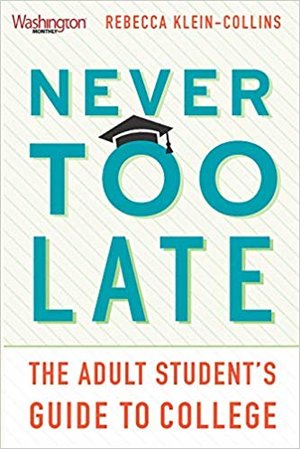 Where can adults turn for advice on going back to college?
Where can adults turn for advice on going back to college?
Adults are really on their own in trying to figure this whole thing out because there isn’t a system in place that’s helping them make these decisions. They can’t go back to their high school and get advice from their old guidance counselor or their kids’ guidance counselor. So even though there’s a lot of lip service paid to the importance of lifelong learning and it’s a no-brainer to go back to school and to get a degree, the real amazing thing is that we don’t have a system that’s set up to help people make good decisions about going back to school.
In an ideal world, we would have a whole network of career and education advisors available to every American. And that’s something that’s really needed, but we don’t have that right now. The more ways we can provide adults with guides or tips or resources to help with their decision-making, the better — because it’s so important to avoid costly mistakes.
What do adults starting this process need to know?
First thing I want them to know: Even though a family member might have gone to a certain college or university, that doesn’t necessarily mean it’s going to be the right choice for them. Certainly ask people you know for their guidance, but keep in mind that you need to do your own research.
No. 2: Find a place that acknowledges who you are at this stage in your life. And that can manifest itself in a number of different ways. It can mean that a school is not expecting you to drop everything and go to school full-time; they understand that you have work and family obligations and they help design a program that’s going to fit into your busy lifestyle. It could also mean a program that really acknowledges the diverse experiences that students are bringing to the classroom — so instructors are not just assuming that you’re coming right out of high school, but that you have learned from your own life — and they see that experience has relevance in the classroom that can contribute to the class in a very unique way.
Third, look for places that have something called a “prior learning assessment.” This is a method for evaluating a student’s [knowledge] that they’ve acquired from work or life or military experience. Some colleges use tests, like the CLEP, to award college credit; others have faculty members create a special exam based on a course; while other schools have a student put together a portfolio of their learning with documentation, and have that evaluated by a faculty member for college credit. It’s really important for somebody who has had a lot of work experience or has had a lot of military training; it can really help you finish your degree a whole lot faster and a whole lot cheaper.
What are your tips for helping adults overcoming their anxieties around going back to school?
A lot of people are nervous about it and are envisioning being the oldest person in the class. This is a totally normal thing to be feeling, but it’s OK, you’re gonna be fine, and there are colleges that will help you succeed.
The book offers some tips for how to build support at home for what you’re trying to do. It includes some exercises to help you recognize all the skills that you already have — this includes time management, attention to detail, things like that.
The other important thing to do is to help adults identify why they want to go back to school. If you can identify what it is that’s motivating you, then that can be your rallying cry when you’re starting to feel discouraged or anxious about starting school.
So in addition to really helping adults ask the right questions about what kind of college is going to support me and be a good fit for me, it’s also helping them really understand why it is they are doing this.
9(MDAxOTAwOTE4MDEyMTkxMDAzNjczZDljZA004))
from MindShift http://bit.ly/2EQrbKq
The Man Cave: How It Can Help Your Physical and Mental Health
from Dai Manuel: Your Lifestyle Mentor http://bit.ly/2AhQLEx
Tuesday, December 25, 2018
How Writing Down What You’re Thankful For Can Be Good For Mental and Physical Health
Over this past year, lifestyle blogger Aileen Xu has kept a monthly gratitude list.
Sometimes it was the big stuff: “I’m grateful that my family is so understanding. I’m grateful so many people care.”
And sometimes it was life’s little blessings: “July 2018: I’m grateful for good hair after I shower.”
Xu started making such lists when she was in college, “at a point when I was just not in a very good place in my life.” Now, the 28-year-old lifestyle blogger and YouTuber recommends the practice to her nearly 750,000 subscribers.
It wasn’t a hard sell.
“I think just over the last few years there’s been more of a trend to focus on gratitude,” says psychologist Laurie Santos, who teaches a course on the science of well-being and happiness at Yale.
Gratitude is being endorsed by wellness blogs and magazines. You can buy different kinds of specific gratitude journals, or download apps that remind you to jot down your blessings.
“Those types of products can remind us to take time to be grateful,” Santos says. “But it’s also important to remember that gratitude is free.”
And noting your gratitude seems to pay off: There’s a growing body of research on the benefits of gratitude. Studies have found that giving thanks and counting blessings can help people sleep better, lower stress and improve interpersonal relationships. Earlier this year, a study found that keeping a gratitude journal decreased materialism and bolstered generosity among adolescents.
In another study from August, high school students who were asked to keep gratitude journals also reported healthier eating. There’s also some evidence it could lower your risk of heart disease and lower symptoms of depression for some people.
That’s why gratitude features heavily in Santos’ happiness class. “It’s one of the practices that really wins out from the field of positive psychology,” she says, because it takes very little time, and “the benefits are so powerful.”
Making gratitude lists is one way of accessing those benefits. You could thank God or the universe. You could keep your gratitude private or share it with others. The best way of accessing and expressing gratitude may be different for each person.
Santos’ students, in addition to keeping gratitude journals, are asked to write a thank you letter and then read it out loud to the recipient. “I can show measurable improvements in well-being even a month after you’ve done this,” Santos says.
What works for some people may not work for others. To find your best method, “[r]eally think about what feels right and what feels natural or meaningful to you,” says Sonja Lyubomirsky, a professor of psychology at the University of California, Riverside, who studies happiness and gratitude.
Some may find that a daily dose of gratitude in the morning can be transformative. “It helps me feel awake and abundantly joyful,” says Sam Khazai, a 38-year-old actor based in New York, who uses a journal that prompts him to list three things he’s grateful for each day.
“I know it sounds kind of meta,” he says. “But practicing gratitude, it brings me so much gratitude in and of itself.”
There have been times, however, when he has skipped a day or even several days when he’s felt especially down. “Or if I don’t skip those days, I’ve straight up lied to my own gratitude journal … I’ve filled it with things I hoped to be grateful for,” he says — but he didn’t feel grateful, and forcing it felt bad.
“Gratitude is a very rich emotion, but it’s also kind of a complicated one,” notes Lyubomirsky. “Sometimes when you express gratitude, you could also feel humbled or indebted or embarrassed. So it doesn’t always feel pleasant.”
In one study Lyubomirsky and her colleagues found that counting blessings once a week boosted happiness, but doing so three times a week didn’t. “That suggests that for most people, at least on average, three times a week was too much,” she says. “And too much gratitude can sort of backfire.”
There’s also a lack of research on how gratitude exercises affect people with clinical depression, anxiety or suicidal tendencies, Lyubomirsky says. “If you’re depressed, and you’re asked to express gratitude … you might have trouble thinking of what you’re grateful for, or you may feel really guilty you haven’t paid back that person you’re grateful for.”
Indeed, for all the research on the broad benefits of expressing gratitude, there’s also evidence that it isn’t for everyone. And it isn’t a panacea — it can’t make injustice, loss, or pain disappear.
What gratitude can do is give us hope. “The research shows that focusing on the positive, in addition to the negative, can boost our mood more than we expect,” says Santos.
In Oakland, Calif., 31-year-old mental health counselor Zeyda Garcia agrees. During really tough times, like when she’d lost a job and was sleeping on her friend’s mom’s couch — she felt like she was reaching for reasons to be grateful.
But she still tried to find some. “Even if it’s just — I’m grateful for the sun that’s shining or being able to wake up,” she says. It felt hokey, and “kind of fake, a little bit.”
But ultimately, it helped. “It allowed me to ground myself,” she says. “It allowed me to remember what was going well, in a world full of chaos.”
9(MDAxOTAwOTE4MDEyMTkxMDAzNjczZDljZA004))
from MindShift http://bit.ly/2BGd1HL
How To Fix Your Slouching Shoulders
from Dai Manuel: Your Lifestyle Mentor http://bit.ly/2EMX8To
Monday, December 24, 2018
5 Pilates Exercises Men Can Do That Build Muscles
from Dai Manuel: Your Lifestyle Mentor http://bit.ly/2RkwCaE
Friday, December 21, 2018
Top 5 Physical Health Benefits of Using CBD Oil
from Dai Manuel: Your Lifestyle Mentor http://bit.ly/2AdaZix
Thursday, December 20, 2018
A Snake, A Sandwich And A Glass Eye: Teachers Share Memorable Gifts From Students
It’s the time of year when schoolchildren and, let’s be honest, sometimes their parents, face a big decision: what gift to give their teacher for the holidays. There’s the old standby, an apple on the desk. Gift cards are also convenient; and homemade cookies can earn bonus points. But many students get far more creative.
In November, the NPR Ed team asked teachers around the country to share their stories of memorable gifts from students. We received more than 800 responses, ranging from laugh-out-loud funny to touching and thoughtful to just plain weird. Here are a few of our favorites.
“All she had to give”
Pamela Brashear set up the story just like any other Christmas tale. It was Dec. 17, 1999, “the last day of school before Christmas break.”
Brashear was just a few years into her teaching career at an elementary school in Viper, Ky., and a quiet girl from a tough home presented her with a gift: a small, faded purse with a single penny in inside.
“I knew in my heart that this gift was most likely all she had to give,” Brashear said. She tried not to tear up as the student insisted she keep it.
Over two decades of teaching, Brashear said she’s kept all her gifts from students. “But this one has a place of honor under my Christmas tree every year. It reminds me of why we give gifts to others.”
50 pounds of spuds
After Margaret Johnson moved to Idaho for a job as a professor, she learned about the state’s hospitality by way of russet potatoes — 50 pounds of them. Johnson told us that a senior in her English class at Idaho State University had a family farm and gave her a share of the bounty.
“The mere volume of potatoes was amazing, and more than I would eat in a couple of years,” she wrote. “I shared the box with all the faculty in my department.”
“Michelle The Pig”
Michelle Fyfe is a high school English teacher and cross-country coach in Fayetteville, Ark. At the beginning of one season, she said, a runner on her team named his pig after her. That fall, “Michelle The Pig” won a blue ribbon at the county fair. And at the team’s end-of-season banquet, the student presented Fyfe with a gift: 15 pounds of bacon and pork cuts.
“Since your pig won,” the student said, “you get to keep her.”
While it was odd to eat something named after her, Fyfe gave the gift top marks.
“No one has ever really thought out that long of a gift,” she said. “That was what was so touching about it.”
The gift of crude oil
Elementary school teacher Susan Zell once received a jar of crude oil from a fourth-grade student. “This gift made me smile with gratitude,” she wrote to us.
The student’s parent worked in oil drilling, and the crude perfectly complemented Zell’s lessons on natural resources. She cherishes it to this day.
“It is sitting in my fine china cupboard,” she wrote. “That’s how special it is to me.”
Literal eye-poppers
Two teachers sent stories that take eye-popping to the literal.
The first is from special education teacher Denise Breyne. It was her final year teaching at an alternative school in suburban Chicago, and her students had gathered around to say goodbye. Breyne said one of those students had a glass eye from a childhood accident. When it was his turn to talk, he told her, “‘Denise, you know that song that goes, ‘Every time you go away, you take a piece of me with you’? Well, here.”
He walked over and popped out his glass eye. Luckily, Breyne already had tissues in her hand.
“It was kind of gross but really kind of wonderful,” she told us.
He had taken his eye out in class before, and while it distressed his classmates, Breyne said it made her laugh so hard she cried.
For her, the glass eye gift represents the power of acceptance. And, yes, if you’re wondering, she kept it.
“Yeah, it just sits in a box in a drawer.”
Shannon Morago sent in a strangely similar story from Arcata, Calif. But this time, the eye was real.
According to Morago, when her biology student had to have an eye surgically removed for a medical condition, the student insisted on saving it for Morago. The student brought the eye to class in a small specimen jar filled with clear liquid. It made her “a little bit squirmy,” Morago told us, but she kept her composure as students passed the eye around.
Morago didn’t keep the eye, but her student did. And years later, that student became a biology teacher herself — a biology teacher who sometimes uses her old eye in class.
A giving student gifts The Giving Tree
Several years ago, Keira Durrett taught a preschooler in Easthampton, Mass., who was learning to read.
Durrett told us that before moving on to kindergarten, the student and her family gave her a copy of Shel Silverstein’s The Giving Tree. The student had signed the inside with red crayon. Also inside was a CD — a recording of the student reading the book.
Durrett recently listened to that CD for the first time in years.
“This child is now a senior in high school,” Durrett wrote us. “But in my mind she will always be a 5-year-old with an enthusiasm for learning.”
An envelope with a tasty surprise
Jill Lowery, a grade school teacher in Des Moines, Iowa, sent a simple, sweet story: “I was given a peanut butter and jelly sandwich made with one slice of bread, folded in half, stuffed in a plain white envelope.”
It was from a first-grader, and the bread was a little crusty by the time Lowery got home. But she wrote, “I was amazed by his ability to think so sweetly of me.”
A memorable set of teeth
Shannon Swain told us about a student she had at a correctional facility near Danville, Calif. She described the student as “gray and grizzled, gruff and grumpy” and told us he rarely smiled because he was embarrassed about his missing teeth.
“That began a bureaucratic adventure and a far-ranging search for free or very low-cost dental care, which we finally arranged at a dental college nearby,” Swain wrote.
Swain ultimately succeeded in getting that student a set of dentures, turning his scowls into beaming smiles.
Years after she left that job, a small, puzzling package arrived at Swain’s parents’ house, where she had been living when she worked at the correctional facility. It included a set of dentures, along with a note: “Dear Teach. I got some new teeth and thought you might like to have these, cuz it was the best present I ever got.”
A snake for a science lover
The way to elementary school teacher Lori Renner’s heart is with dead snakes. Renner told us that several years ago, a third-grade student returned from a family vacation in Florida with a dried-up dead snake in a plastic bag — just for her.
Renner wrote, “The fact that this student … found a dead snake fascinating enough to bring home from a vacation, and then pass on to me, because she knew I would love it, makes me so so happy.”
The snake has followed Renner to three different schools around Seattle.
“I treasure it because it reminds me of how wonderfully thoughtful young children are.”
9(MDAxOTAwOTE4MDEyMTkxMDAzNjczZDljZA004))
from MindShift http://bit.ly/2EHFDUX
Personal Trainer Salary: How Much Can I Make?
from Dai Manuel: Your Lifestyle Mentor https://ift.tt/2PSckQX
Wednesday, December 19, 2018
A New Way To Get College Students Through A Psychiatric Crisis — And Back To School
Sometimes a psychiatric crisis can be triggered by something small. For Alexia Phillips, 21, it was a heated argument with a close family member in February 2017. She remembers the fight blew up before she left the house to go to classes at Queens College in Flushing, New York.
By midday, Phillips, then a sophomore, says she began to cry loudly and uncontrollably.
“It really triggered me. I just got really angry really fast…I was crying so much I couldn’t breathe and couldn’t talk. I didn’t know how to handle it,” she says.
As she would come to understand later, Phillips was experiencing symptoms of her underlying borderline personality disorder, anxiety and depression. But at the time, all she knew was she felt too overwhelmed to go home, or to go to class. She also didn’t want anyone to see her like that. Finally, she went to her college counseling center for the first time and asked for help.
Minutes later, Phillips’ counselor, a college public safety officer and a paramedic trained to deal with psychiatric crises, calmly and unobtrusively escorted her to the back of the college through a quiet hallway door that led out to a parked ambulance sent from Zucker Hillside Hospital. She was ferried — without the lights or sirens — to be assessed at the hospital’s special program for college students.
This kind of response to a student crisis is unusual. In a lot of colleges, if staff think the student who’s having a crisis may be unsafe, they have little choice but to call 911. Many schools lack resources to address serious crises and students are left to navigate the health care system on their own.
But Queens College is part of the Behavioral Health College Partnership, an innovative mental health program run by Northwell Health, a health care system in New York, in partnership with more than 77 colleges in the New York metropolitan area. The program provides behavioral health care tailored to college students’ lives, including emergency evaluations, counseling, and inpatient treatment.
Laura Braider, a psychologist and director of the Behavioral Health College Partnership says she launched the partnership in 2009 with Blaine Greenwald, a psychiatrist at Northwell Health because she wanted to create a more therapeutic approach to handling student breakdowns.
“We saw a lack of ability to effectively treat college students in need of care. These students are not adults and not children and need specialized programming to meet their needs,” says Braider.
Their approach starts at the moment of crisis — avoiding that 911 call which Braider says can be mortifying for students — and extends through inpatient care if needed, including support for the transition back to campus. It’s designed to make it possible for students to get treatment and then reintegrate into their academic life with as little disruption as possible.
“We try to minimize any secondary trauma to students who are already overwhelmed,” says Braider.
More than 3,200 students have been admitted to the program since it began.
For students who need inpatient care, the program has a special unit at Zucker Hospital — a friendly dorm-like environment where students can keep a sense of normalcy as they stabilize.
Dr. Marta J. Hopkinson, a psychiatrist and director of mental health at the University Health Center at the University of Maryland in College Park says specialized programs like the Behavioral Health College Partnership fill an important void for college students.
The number of students coming to college with mental health issues has increased over the years and counseling centers are struggling with the demands of these students when they’re in crisis, says Hopkinson who is also the chair of the mental health section at the American College Health Association.
“Most schools can’t expand enough to meet the demands of all the students who want and need psychotherapy,” she says. “We’re all working to prevent these kids from falling through the cracks.”
Making it on their own
College is a vulnerable time for a student’s mental health. Many serious psychiatric illnesses, including major depression, anxiety disorders and substance abuse also present themselves between the ages of 14 and 25, according to the National Alliance on Mental Health.
One in three college freshmen worldwide report having a major mental health disorder; the most prevalent being depressive disorder followed by an anxiety or substance use disorder, according to a study published in the Journal of Abnormal Psychology in September.
And suicide is the second leading cause of death among college-aged people, according to the Centers for Disease Control and Prevention.
But colleges often struggle to provide effective treatment options, says Randy P. Auerbach, an associate professor in the psychiatry department at Columbia University College of Physicians and Surgeons and lead author of the study on the prevalence of mental disorders.
“Only a minority of students are seeking out treatment, creating a conundrum on campus,” he says. “Lots of administrators everywhere are scrambling to find innovative ways to reach students in need.”
Typically, when college students need acute hospitalization for a psychiatric problem they’re put in psychiatric services with other adults with serious mental health problems. These can be “fairly frightening places” says Dr. Victor Schwartz, the chief medical officer at The Jed Foundation, a nonprofit that supports campus efforts to improve mental health services and prevent suicide. “They can be particularly upsetting for a college kid with transient problems or in the early stages of a mental illness,” he says.
In contrast, the Behavioral Health College Partnership treats students at a specialized hospital unit within Zucker Hospital that’s only for young people. It looks and feels like a dorm. Patients have double rooms where they can settle in with their favorite stuffed animals and other comforting items. There’s a common area with TV, an exercise bike, a ping pong table and a piano. Students can grab snacks and beverages any time, and they eat together in a lunchroom environment.
Arriving in this environment was a welcome relief for Alexia Phillips after her crisis. She had never been in a psychiatric facility before. “All I knew was what I learned from movies I saw about it so I was terrified,” she says.
But once Phillips got settled into the specialized college wing, she says she enjoyed it. “It was more like being in a college dorm,” she says. “Everyone was really nice and I made friends there. The kids were all like me. We could talk openly about how we felt.”
More importantly, Phillips, who had been going to outpatient therapy for being bullied and for cutting before her psychiatric crisis, was relieved to finally get a diagnosis for her problems. She started into dialectical behavior therapy, known to be effective for borderline personality disorder and mood disorders.
“I got good therapy and good medication,” she says.
Transitioning back to school
Many colleges will refuse to take back students who have a suicide attempt, because of liability concerns. And being out of school to get treated for a mental health crisis can set students back academically; some will struggle to get back on track to finish their school semester.
To prevent this, the Northwell mental health partnership focuses on family and school engagement, staying in touch with the school counselors and administration throughout the treatment process.
It starts when a student is being transported to the hospital; their college prepares and sends a history of the student, including any substance abuse, past psychiatric treatment and other risk factors for suicide.
“Without collateral material from the school we’re not seeing the big picture,” Braider says.
Braider believes allowing “communication to seamlessly flow” between the hospital, college, the student and their family during hospitalization benefits everyone. And, colleges respect their assessment of the student’s readiness to return to campus life.
“Once the hospital gives us their report when a student is released saying that the student is well and ready to be integrated back into school we accept that. We work hard to get the student back into school,” says Dr. Barbara Moore, a psychologist and director of Queens College Counseling, Health and Wellness Center which has been involved with the mental health partnership since 2011.
When the student is stabilized, a liaison contacts all the teachers and works out a protocol for what how they can catch up academically.
Not every student comes right back, however. If they missed too many classes Moore says she might encourage a student to take an incomplete to make up the work without pressure.
“We try the best way we can to figure out a transition that works well for them,” she says.
The partnership’s approach worked well for Damian Escobar when he had a serious crisis in November. Escobar, 18, a freshman at Hofstra University in Hempstead, New York, says he became “really stressed” trying to keep his grades up to retain his scholarship.
Escobar, who had been already diagnosed with depression and anxiety before he began college, had failed to keep several appointments at Hofstra’s counseling center.
“I went to classes and just sat there. I wasn’t doing anything. I was too depressed to talk about my issues,” he says. He felt he couldn’t talk to his mom about it.
Eventually, Escobar began having suicidal thoughts and attempted suicide.
Escobar heard about the program and his mother and grandmother drove him to the collegiate unit at Zucker Hospital. He received daily therapy and was involved in family meetings and coaching. About 10 days later, he felt ready to get back to school.
Before being released, he worked with the partnership’s college liaison, Danielle Cimafonte, to figure out how to relieve some of his stress. He dropped one of his five classes without penalty and is back at Hofstra.
“When I came out of the hospital I was like a completely changed person. After my treatment and new medications my mood became completely different,” says Escobar.
His depression made him shy and sheltered. After his hospitalization he went back to school and back to being the “loud and open like the guy he used to be.”
It worked for Alexia Phillips too, who went back to school after her stay at Zucker Hospital. She says she feared the medications she was prescribed on the unit would turn her into a zombie.
“But I’m just the same way I was. It’s just helping me with my depression,” she says.
It has been a year that she stopped cutting herself.
Cheryl Platzman Weinstock is a journalist who reports on health and science research and its impact on society.
9(MDAxOTAwOTE4MDEyMTkxMDAzNjczZDljZA004))
from MindShift https://ift.tt/2ED4sBD
How to Cook Healthy Meals for a Healthier Body
from Dai Manuel: Your Lifestyle Mentor https://ift.tt/2QCdCER
Tuesday, December 18, 2018
How to Build Muscle at Home Without Weights
from Dai Manuel: Your Lifestyle Mentor https://ift.tt/2Cj45d8
Monday, December 17, 2018
How To Make Sure Your Math Anxiety Doesn’t Make Your Kids Hate Math
A spike in blood pressure. A racing heart rate. Sweaty palms.
For many adults, this is what they feel when faced with difficult math.
But for kids, math anxiety isn’t just a feeling, it can affect their ability to do well in school. This fear tends to creep up on students when performance matters the most, like during exams or while speaking in class.
One reason for a kid’s math anxiety? How their parents feel about the subject.
“A parent might say, ‘oh I’m not a math person, it’s okay if you’re not good at math either,’ ” Sian Beilock, cognitive scientist and President of Barnard College, says. “It can send a signal to kids about whether they can succeed.”
But new research from Beilock and her team shows that parents don’t have to overcome their fear of math to help their child succeed, as long they changed their attitudes about the subject.
The researchers gave families in the Chicago area math-related bedtime stories to read at night, through an iPad app called Bedtime Math. The stories featured fun facts about walking frogs or the world’s largest cupcake. After reading the stories with their parents, kids answered questions about what they just read, practicing simple addition or measuring the amount of an ingredient. Families did this for a total of three years — while kids grew from first to third grade — because this is when kids tend to solidify their fear of math.
After a year of reading these stories, parents felt more confident in their children’s math potential and valued the importance of math skills more. Now, after three years, when those students were tested on their math ability, they did just as well as the kids whose parents felt confident about math.
One caveat: Two years into the study, families rarely used the app (less than once a week) and parents still felt anxious about their own math skills. Using the app to read bedtime stories didn’t get rid of math anxiety — it was a way for families to normalize math at home and foster a relaxed dialogue around the subject. There’s more than one way to do it: Beilock suggests other fun activities like puzzles and cooking give families an opportunity to talk about math.
Creating an environment in which math is part of everyday life won’t transform kids into overnight math sensations, but perhaps it can help kids realize math is a subject for curiosity, discussion and growth.
“It’s almost socially acceptable to be anxious about math,” in a way that doesn’t apply to reading, Beilock says. But early math skills form an important foundation for academic success and have predicted achievement later in school, including reading skills.
9(MDAxOTAwOTE4MDEyMTkxMDAzNjczZDljZA004))
from MindShift https://ift.tt/2PMxH5Y
The Ultimate Personal Trainer Resume Guide: Everything You Need to Get Hired
from Dai Manuel: Your Lifestyle Mentor https://ift.tt/2PI7lC8
Sunday, December 16, 2018
Merry Christmas Cookie Boxes

It’s that time of year! Cookies and goodies and sweets and treats! And I’ve got a little bit of everything in this sugar-filled Christmas Cookie Box to satisfy even the biggest sweet tooth. I spent the better part of three, no almost four days baking and playing in the kitchen to make enough to share with friends and family. And when I was done, I said I will never bake again. But we know that’s not true. But OMG was I tired.
I’ll give you a couple of planning tips at the end if you want.
Now, let’s see what these big, beautiful boxes are stuffed with. Links to each holiday treat are included below.
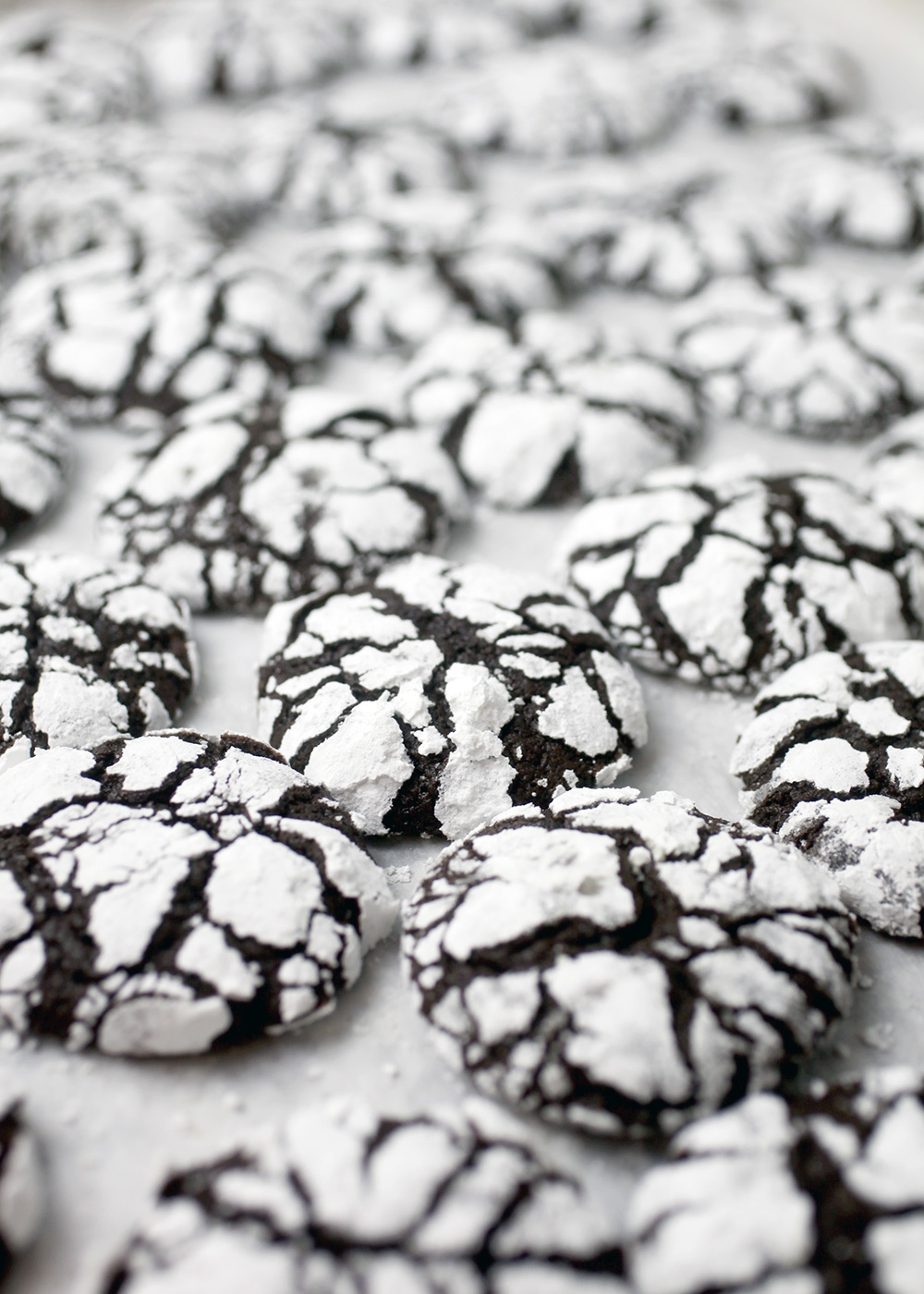
First up, CHOCOLATE CRACKLES. I love them! These chocolatey cookies are a fave and always so festive for the holidays. It’s super satisfying to watch them bake and go from a ball, completely covered in powdered sugar to a crackled surface revealing the dark chocolate cookie underneath.
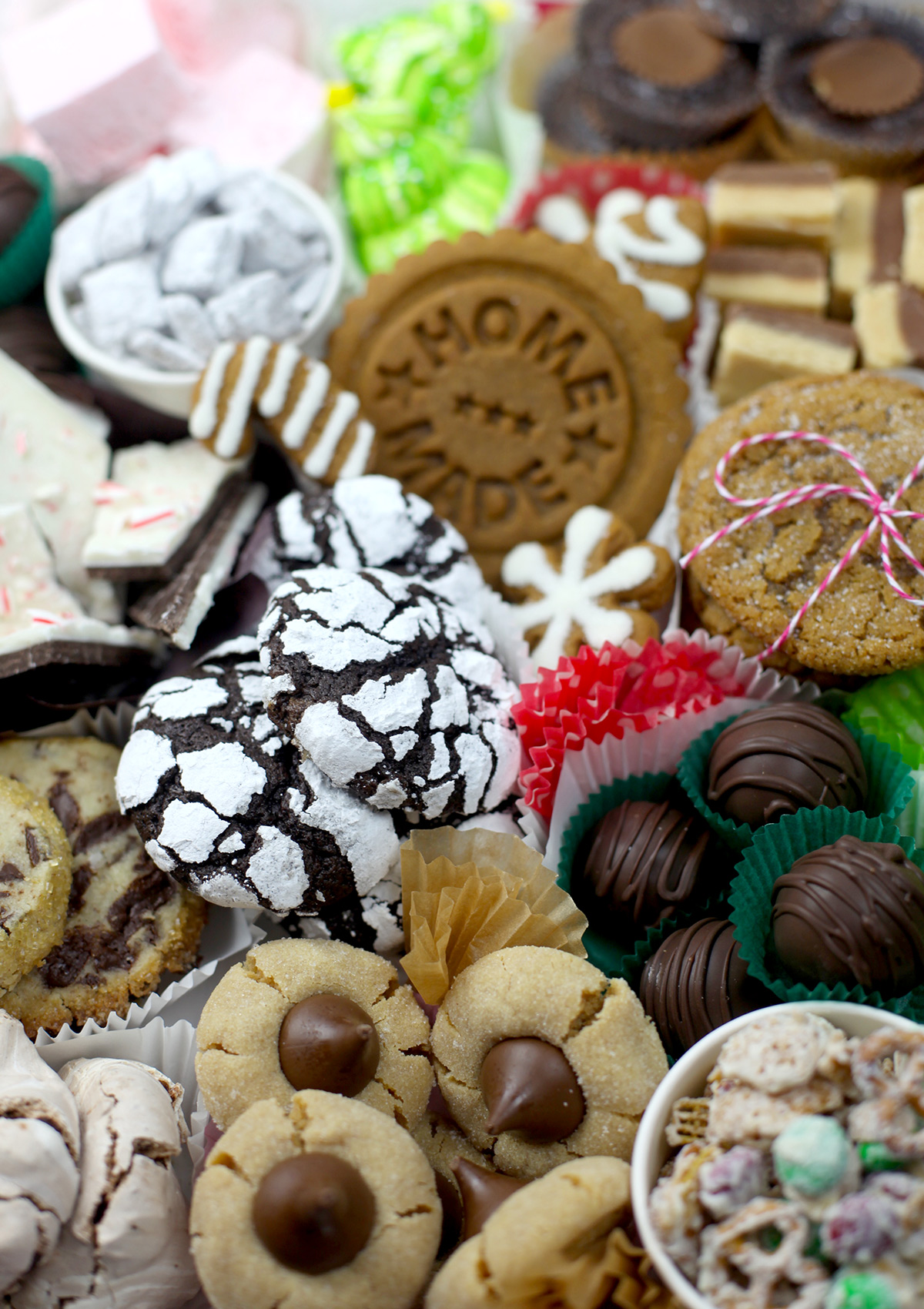
I mean look how pretty they are and how much they stand out against all the other sweets they’re sitting next to.

Oh yes! PEANUT BUTTER BLOSSOMS. Always and forever. These puffy peanut butter cookies are pressed with Hershey Kisses right out of the oven. Chocolate and peanut butter. One of my all-time favorite combos.
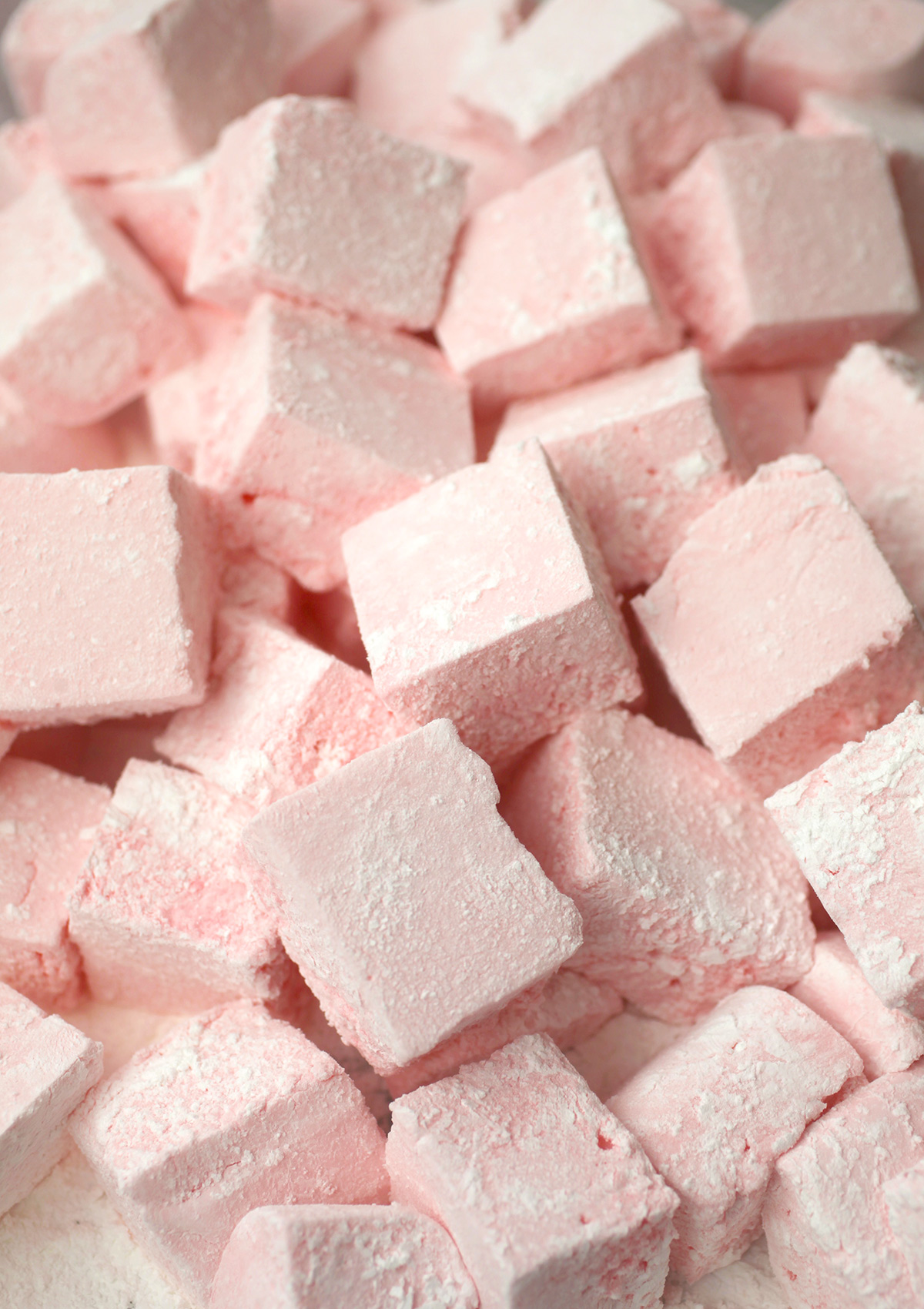
HOMEMADE MARSHMALLOWS. Please, please try making these one day if you’ve never attempted them before. There’s something about them that makes you feel magical when it all comes together. And they taste amazing! Use the linked recipe, but just pour the marshmallow in one 13 X 9 glass baking dish for super thick squares.
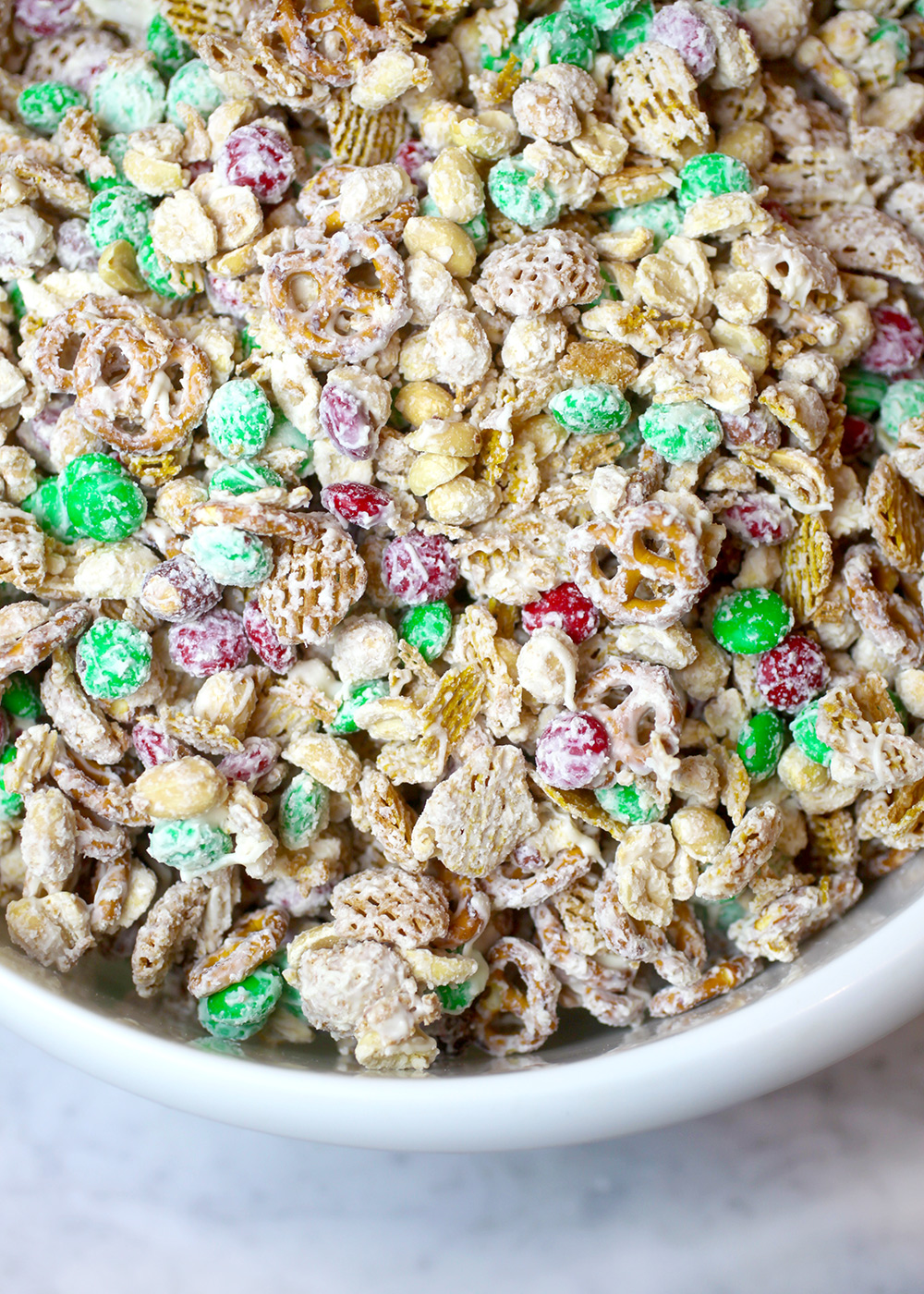
Okay, let’s talk about this CHRISTMAS CRUNCH. Or what it’s usually referred to as … Christmas Crack. I’ve just always felt weird promoting it like that. But, I guess it got that name for a reason. It IS very addictive. Also, if you don’t like baking, it’s one of the easiest things you can make. It’s basically, just salted peanuts, rice or corn cereal, M&M’s, pretzels and melted white chocolate. The recipe makes a ton. So, even though you’ll want to eat it all yourself, you’ll have plenty to share.
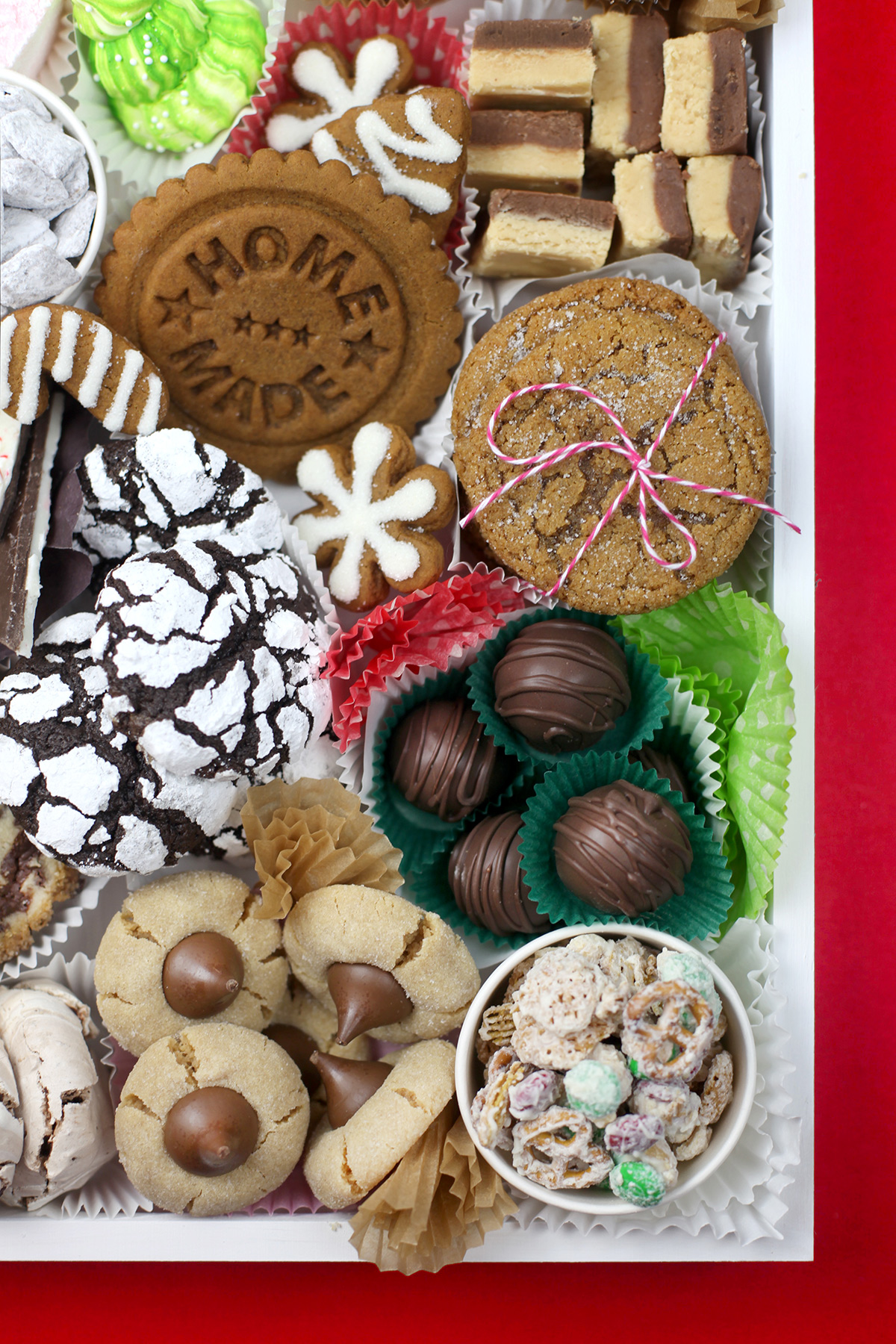
When I packaged them in the cookie box, I placed them in small white ice cream cups with plastic domed lids so the pieces wouldn’t accidentally spill out. You can also use plastic treat bags.
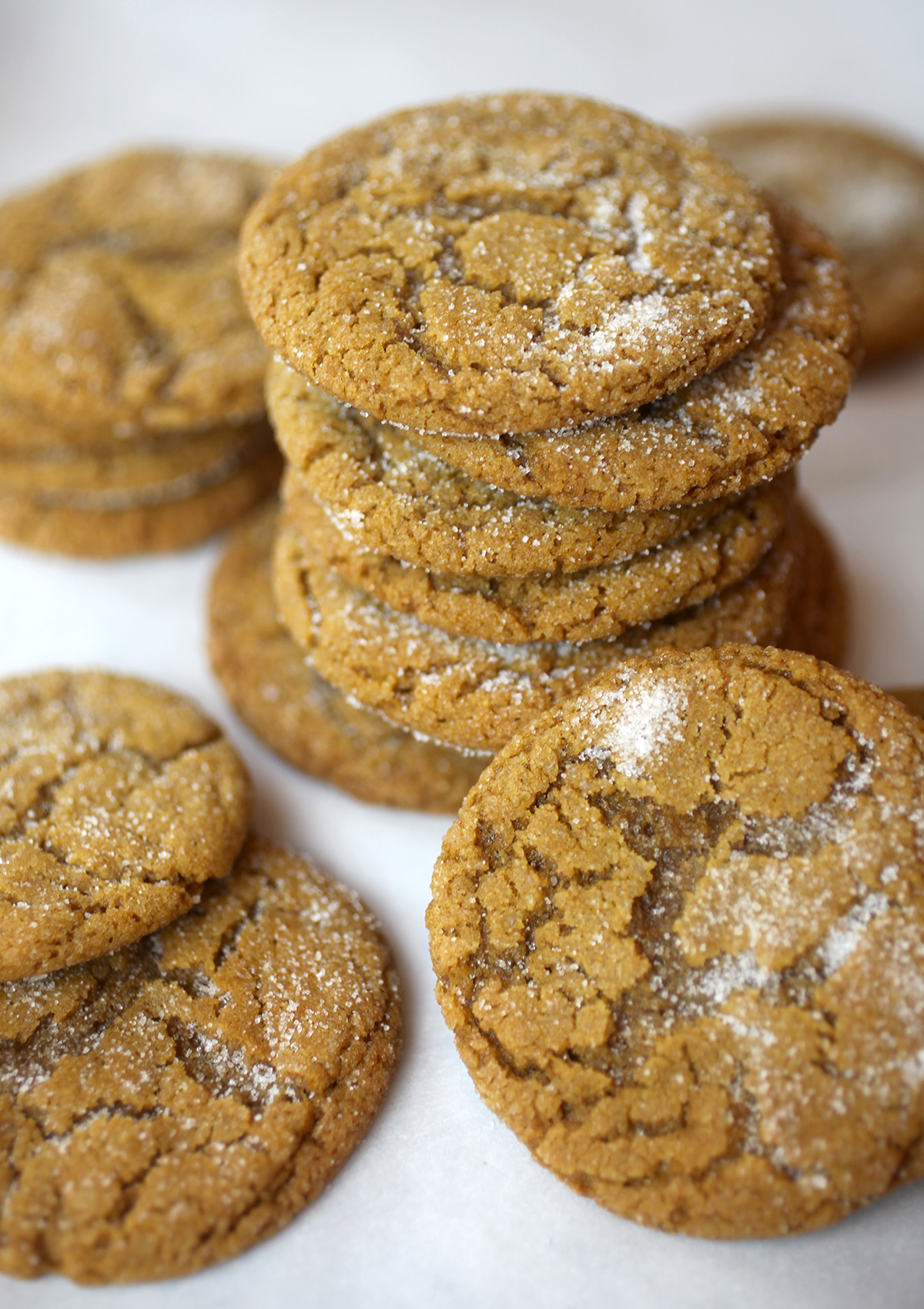
Here we have some MERRY GOOD MOLASSES COOKIES. They are a crowd pleaser and will probably be one of the first things to disappear on your cookie tray.

CHEWY CHOCOLATE MERINGUES. These are an unexpected favorite. Crunchy, chewy and chocolatey. What they lack in looks, they make up for in taste. Oh, so good.
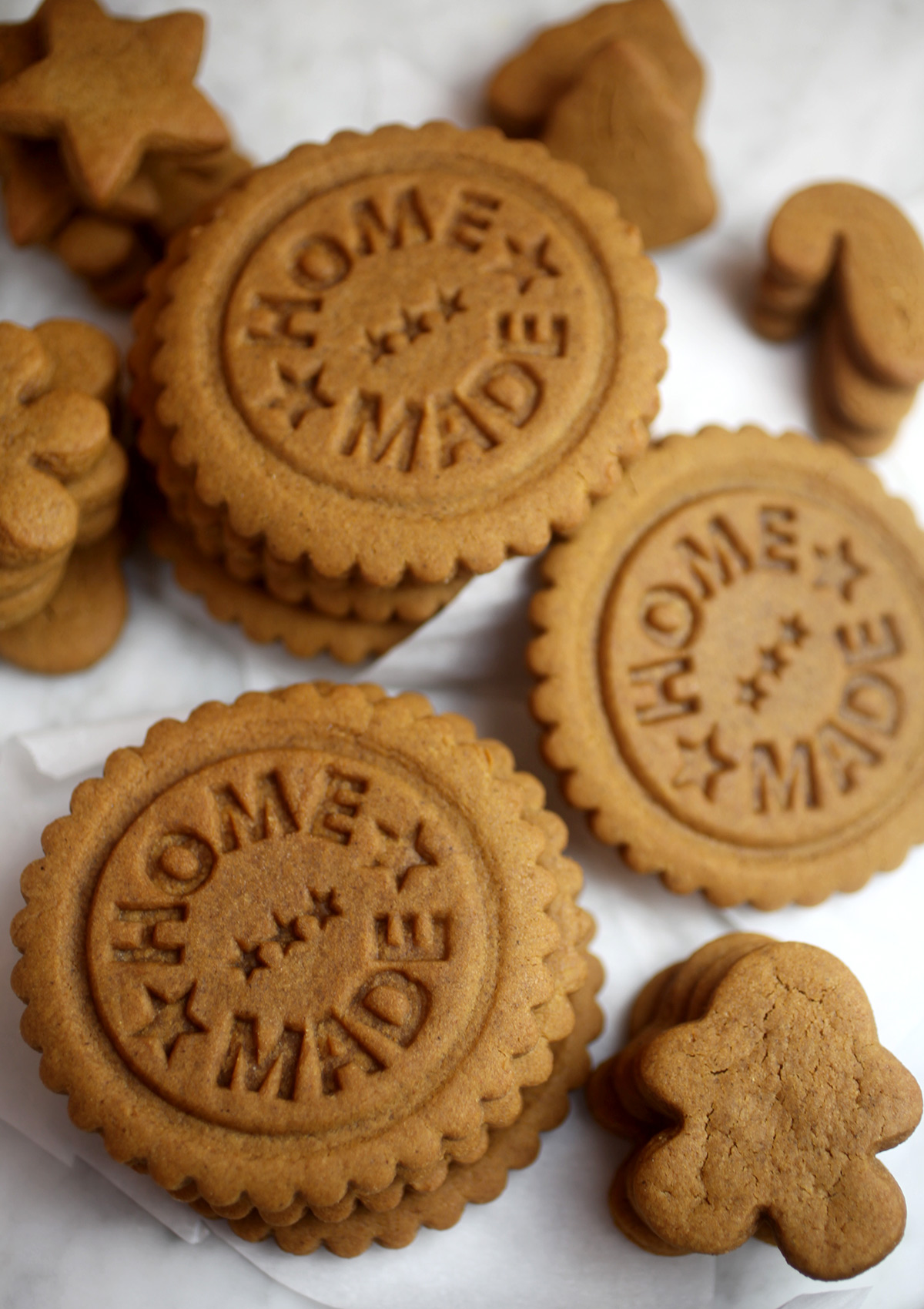
GINGERBREAD COOKIES. A staple during the holidays. This recipe is easy to whip up and enjoy as is. For a more dramatic look, you can pipe and outline them with royal icing or even melted white chocolate. Sprinkle with sanding sugar while still wet and then let dry for a snowy look.
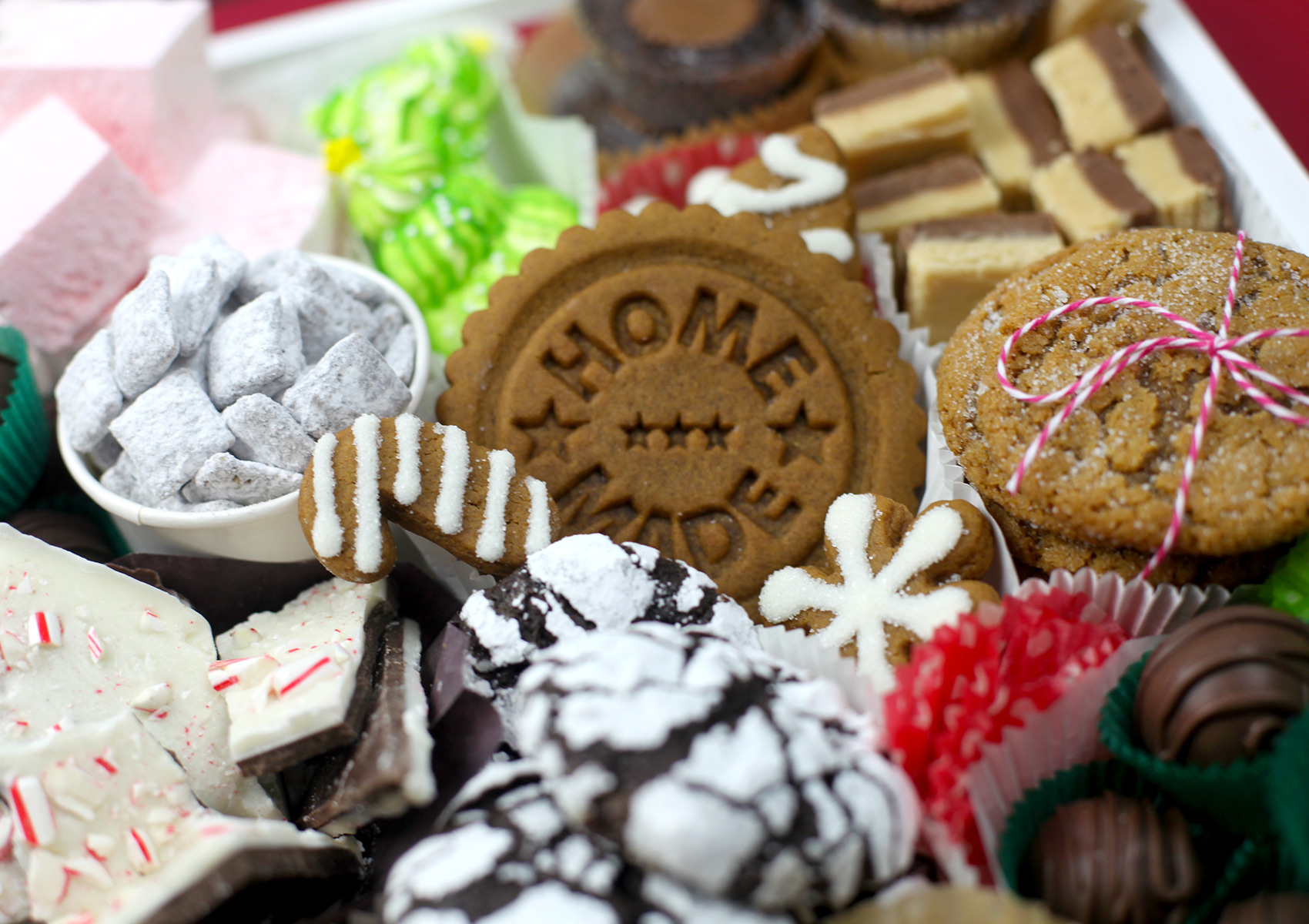
I used a cookie stamp and fluted round cookie cutters to “decorate” them. Just a little reminder that everything inside the cookie box is made from the home and heart.
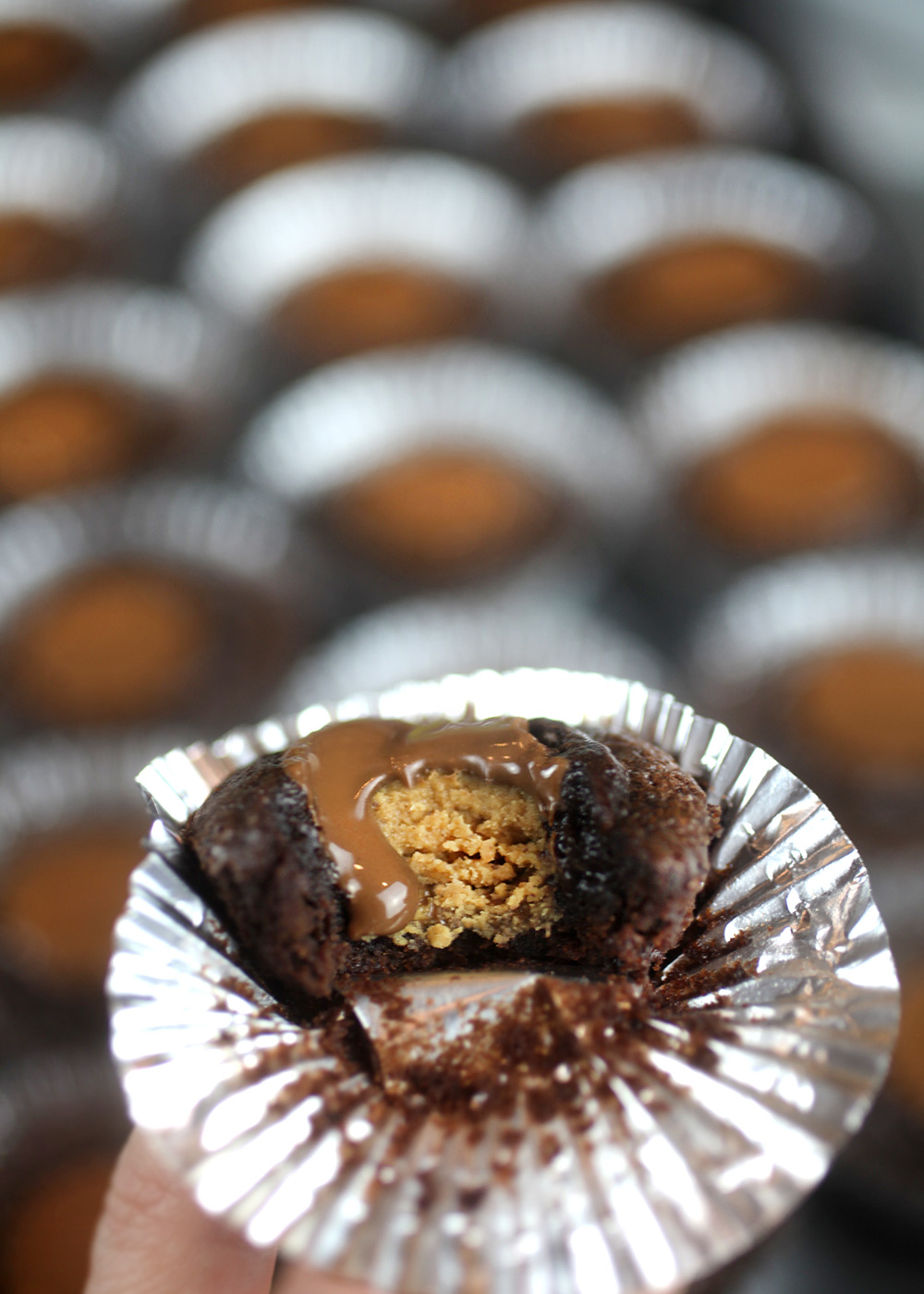
Oh gosh! I have too many favorites. These BROWNIE CANDY CUPS are little bites of heaven. Again peanut butter and chocolate, but I don’t care. Bake these in 2-inch foil Reynolds baking cups for a two bite-treat … that is if you can find them. I always have a tough time so I just recently bought a box set of them off Amazon. That’s enough for 1,152 treats, so I think I’m set for a few awhile. The foil cups are bigger than a mini cupcake liner, but smaller than a regular cupcake liner. But still make them even if you have to use a larger size. Just bake them a few minutes longer if needed.

CHRISTMAS TREE MERINGUES. These are super festive and fun. I tinted the meringue a light green and then piped them using an Ateco #864 decorating tip and a piping bag lined with green icing color for darker streaks. Pipe large rounds of meringue, followed by a slightly smaller dollop in the middle and an even smaller dollop on the very top. To decorate, I sprinkled with white non-pareils and topped them off with a tiny yellow sugar star. You can use the linked recipe and just swap out the decorating part.
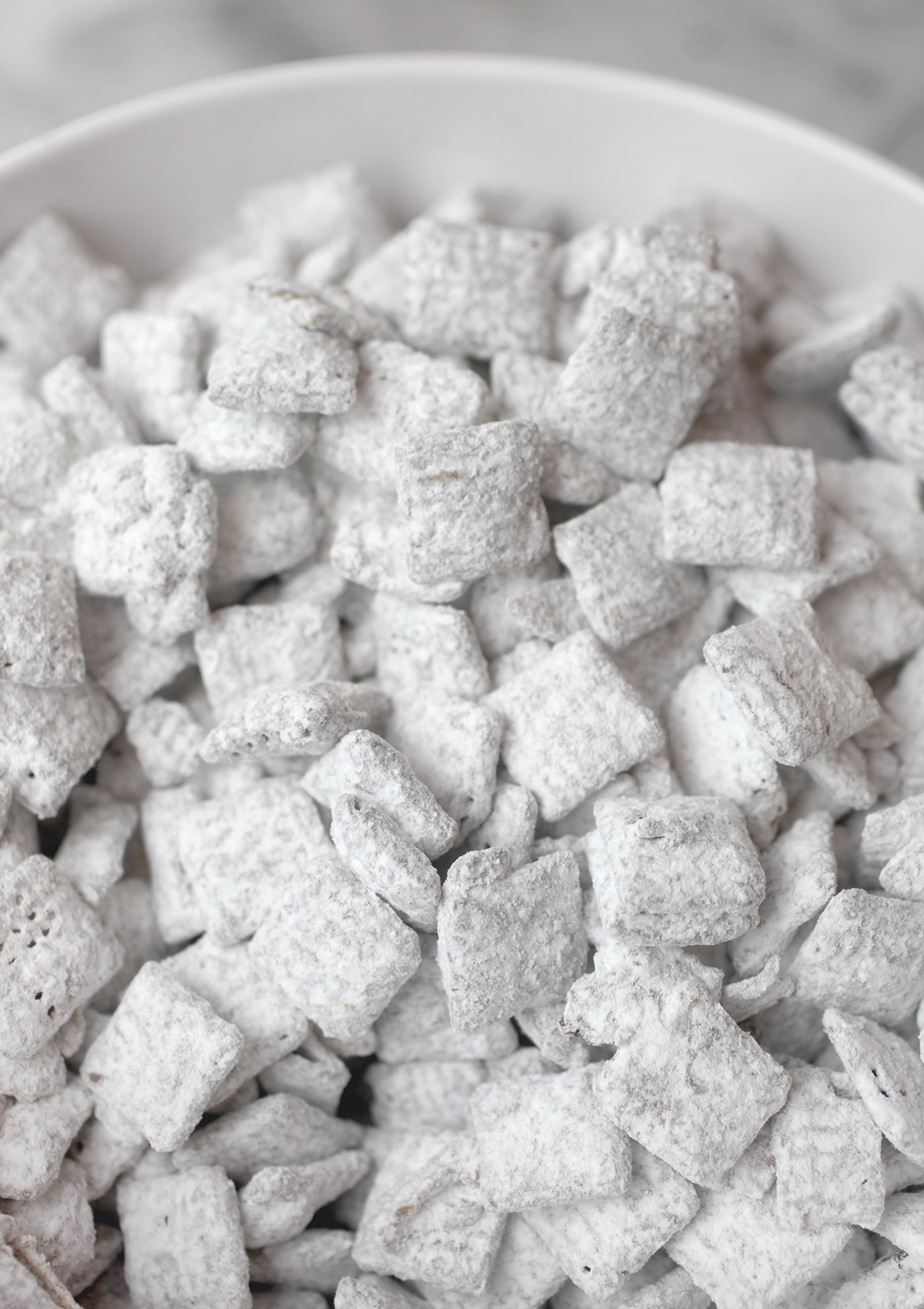
REINDEER CHOW! Or puppy chow as it’s known the rest of the year. This is another no-bake treat and yields an extremely high satisfaction rate based on the effort needed to make. It’s takes around five minutes and uses only four ingredients. Rice or corn cereal, peanut butter, chocolate and powdered sugar. Go make some right now, you won’t regret it.
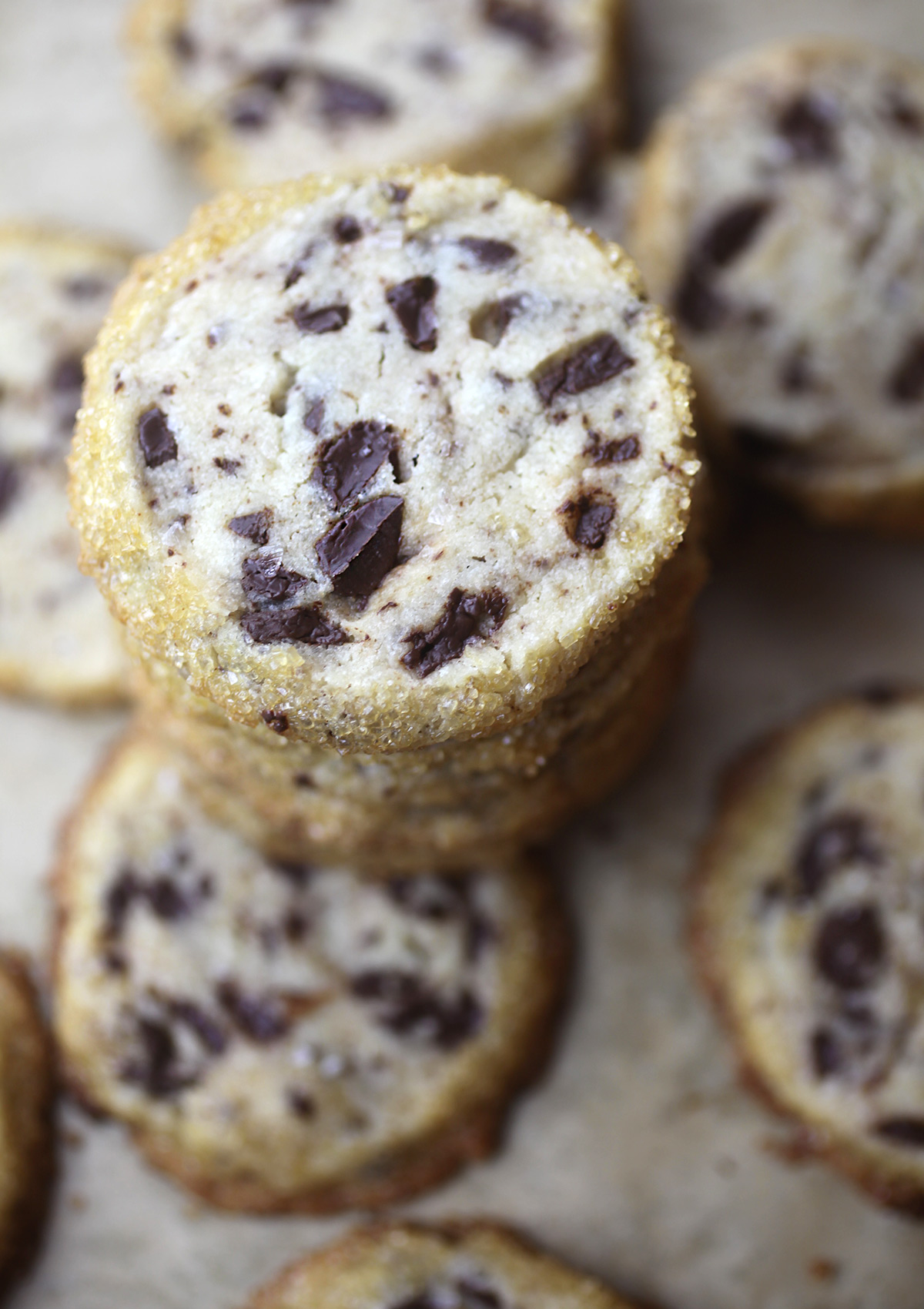
SALTED CHOCOLATE CHUNK SHORTBREAD COOKIES. An upscale version of a chocolate chip cookie that seemed perfect for Christmas. They’re sliced cookies, packed with chunks of bittersweet or semisweet chocolate and then rolled in demerara sugar and sprinkled with sea salt. So much goodness!
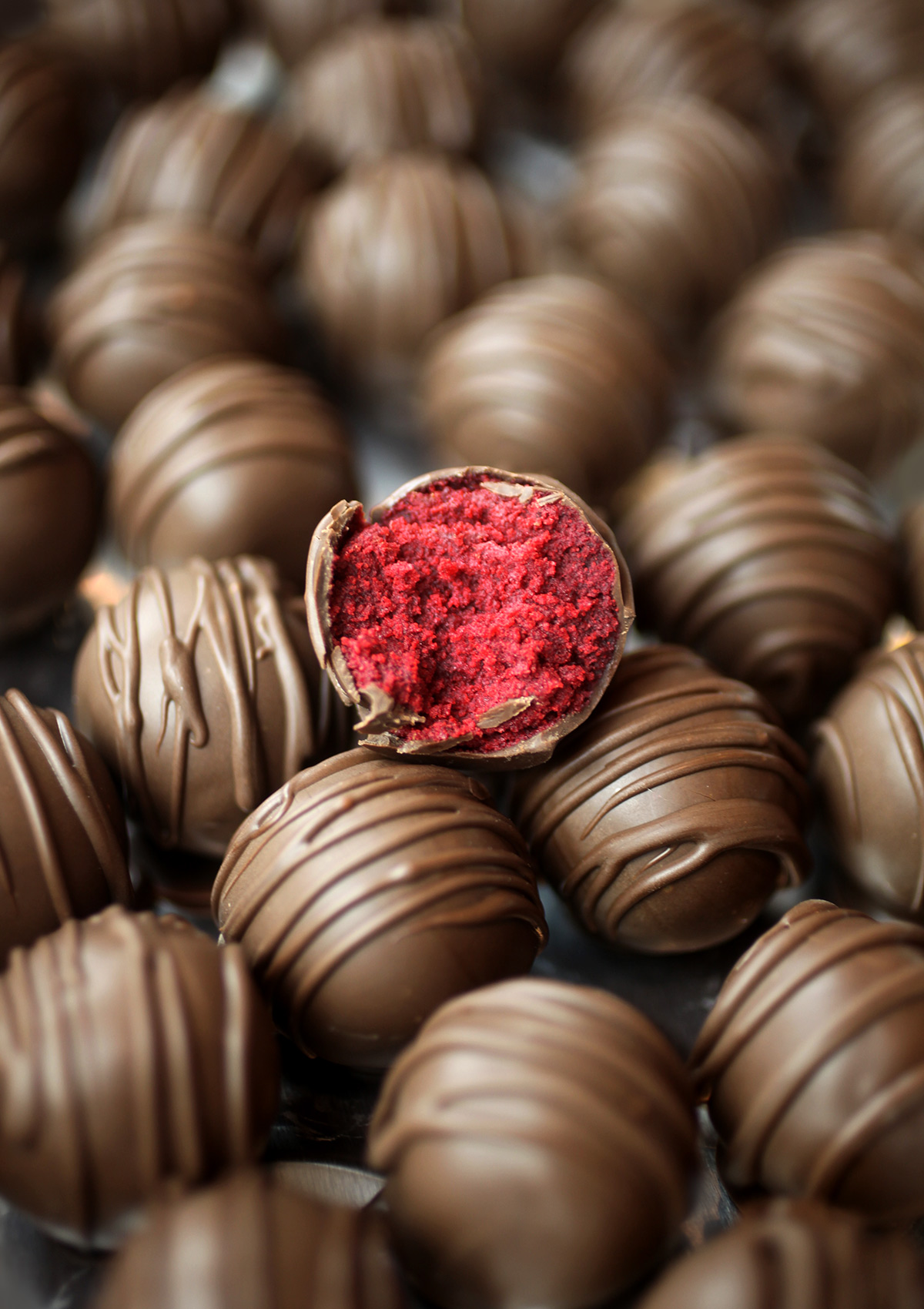
You know these had to make an appearance. RED VELVET CAKE BALLS. So pretty, so festive, and so good. I’ve been making these for over ten years now and they are still one of my all-time favorites, any time of the year.
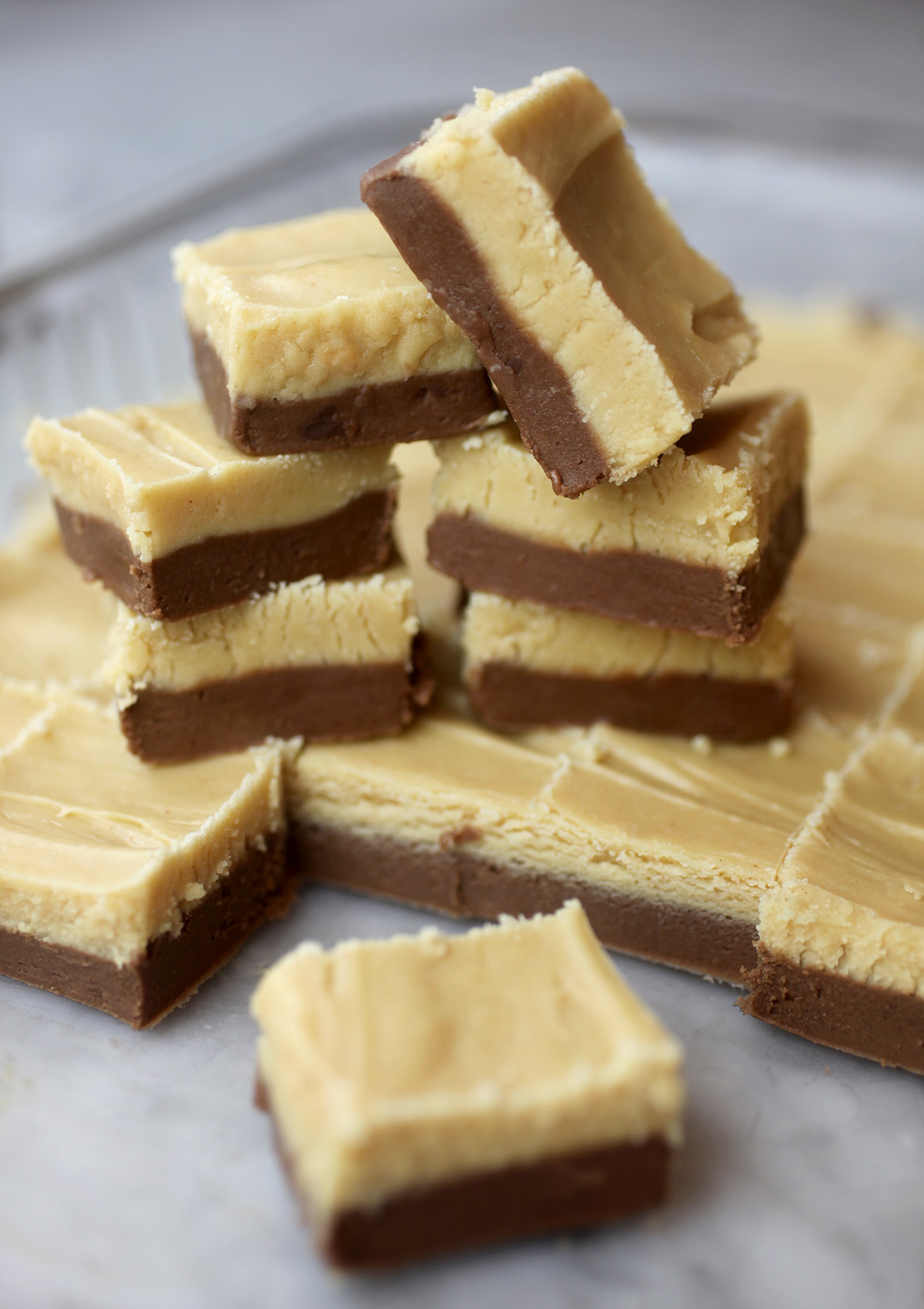
PEANUT BUTTER FUDGE. Umm yes, with chocolate, too. This is the creamiest, sweetest, most decadent fudge you can sink your teeth into. I have been making it every single year for gosh, maybe twenty years now. It’s always expected at any holiday get together.

And finally, another staple. PEPPERMINT BARK and it’s really easy. Line a pan with wax paper, pour melted chocolate candy coating on top and smooth out to dry. Next pour vanilla candy coating on top of the chocolate and sprinkle with crushed candy canes. Let dry completely and then break into small pieces. Easy peasy. The link above is to an Easter version for step-by-step pics.

When you have everything made, assemble in a cookie box or tray and gift to friends. I used a random assortment of paper baking cups in different sizes and colors to organize everything. But feel free to get creative with different ribbons, twine, boxes, and cardboard cutouts for dividers.
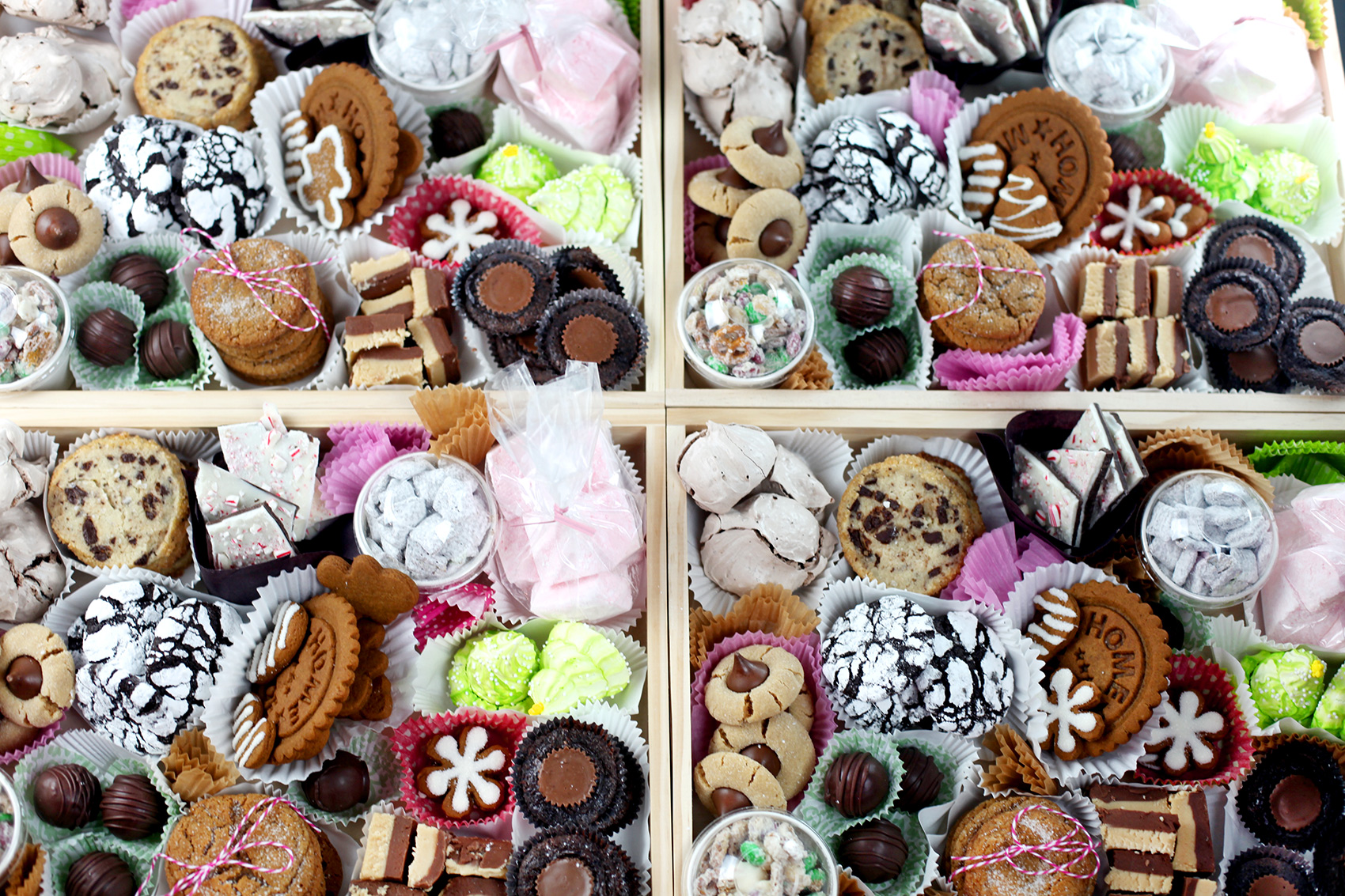
The fourteen, yes 14!!! treats I made were enough to fill up 7 of these 16 X 12 X 2 wooden boxes I found at Target. This was a lot even for one gift, so smaller boxes or containers would still be great and of course yield more gifts.
Here’s the order I made things for maximum freshness if you’re curious
Day 1:
Made the following sweets first since they have a longer shelf-life:
Reindeer Chow
Christmas Crunch
Peanut Butter Fudge
Peppermint Bark
Baked cake ahead of time for cake balls
Day 2:
Prepared cookie doughs and chilled them in the fridge:
Molasses Cookies
Gingerbread Cookies
Chocolate Crackles
Chocolate Chunk Shortbread Cookies
Day 3:
Chocolate Meringues
Christmas Tree Meringues
Marshmallows
Red Velvet Cake Balls
Cutout and baked the Gingerbread cookies
Day 4:
Baked the rest of the cookies saving them for last to be as fresh as possible:
Molasses Cookies
Chocolate Crackles
Chocolate Chunk Shortbread
Made and baked Peanut Butter Blossoms
Made and baked Brownie Candy Cups
Then I packaged everything up and delivered to friends and family the next day.
Here’s the wooden box I found at Target for $6.99.
Also, if you want to make treats, but don’t like to bake, the following are all no-bake sweets:
Marshmallows
Reindeer Chow
Christmas Crunch
Peanut Butter Fudge
Peppermint Bark
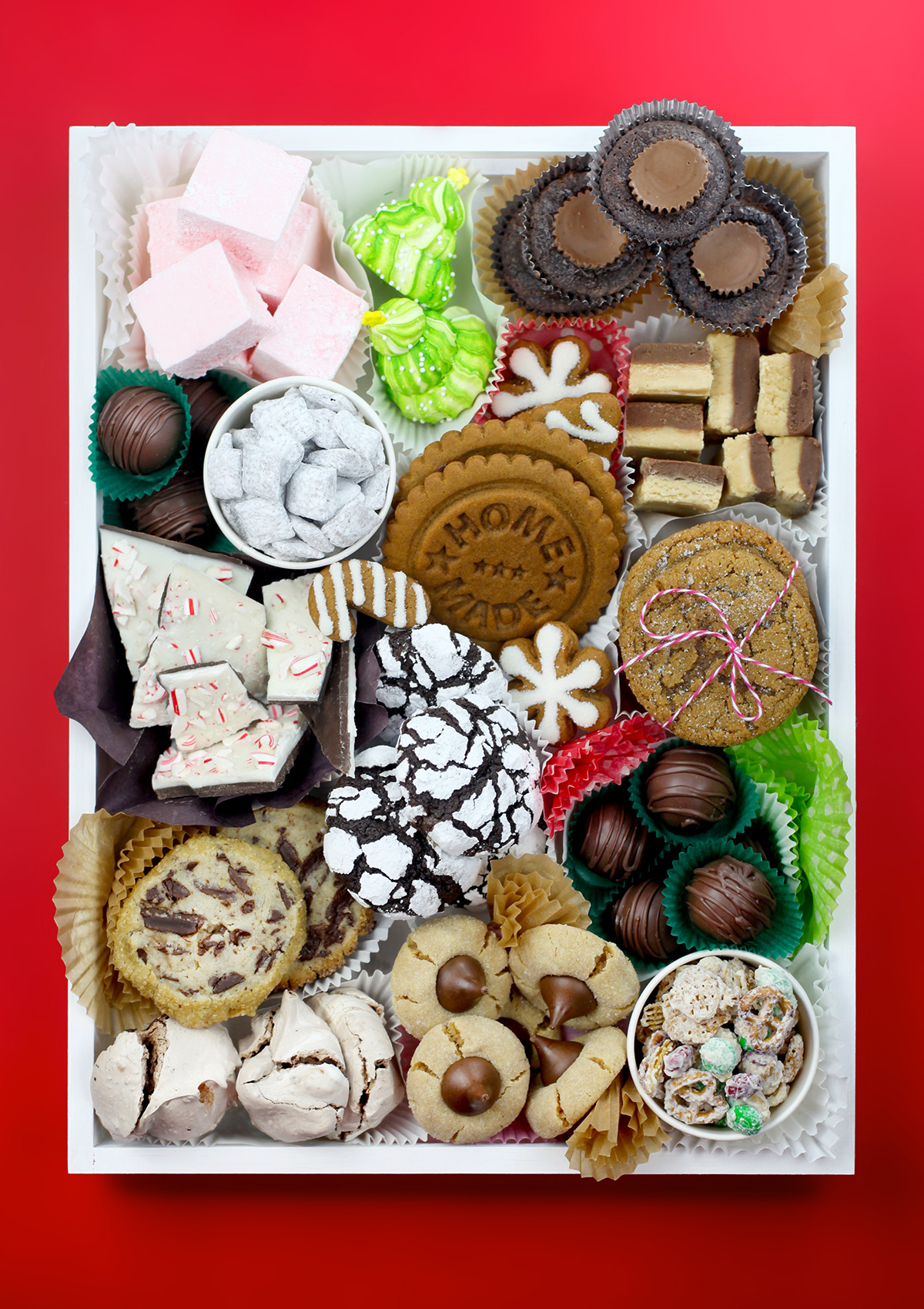
I hope you enjoy these cookies and have a Merry Sweet Christmas!!!!
from bakerella.com https://ift.tt/2EyUTUk
Saturday, December 15, 2018
Salted Chocolate Chunk Shortbread Cookies
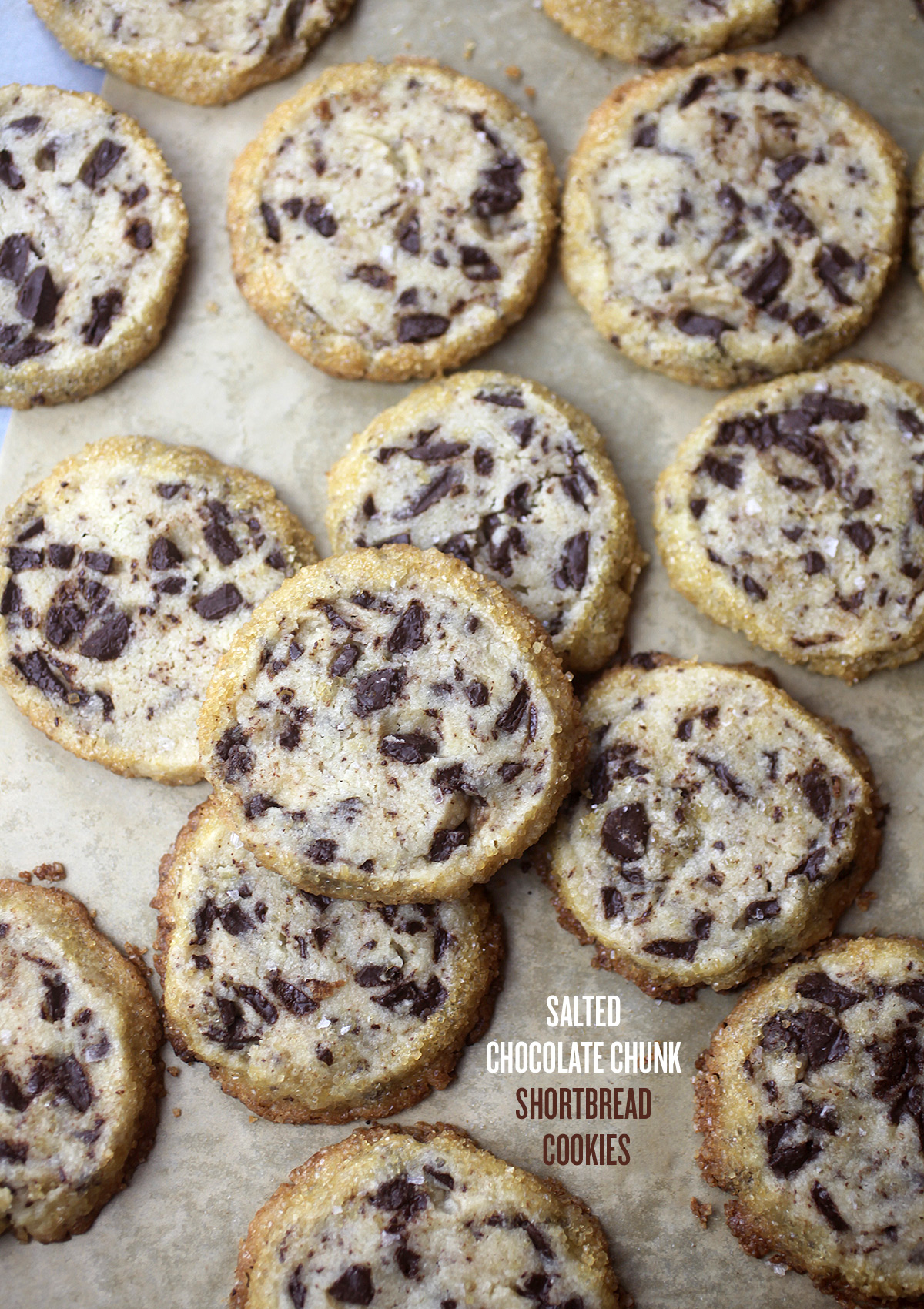
Better late than never. I finally made my way to baking these little gems. You may have seem them all over instagram the past many months from a recipe by Alison Roman. (Linked below) And now I know why. These Salted Chocolate Chunk Shortbread Cookies are special.
I decided to give them a try to add to a Christmas Cookie Box (I’ll be posting soon) and I thought they’d make a more upscale version of a chocolate chip cookie to add to the holiday mix. And I love how they turned out.
I hope you make them and enjoy them as much as I did.
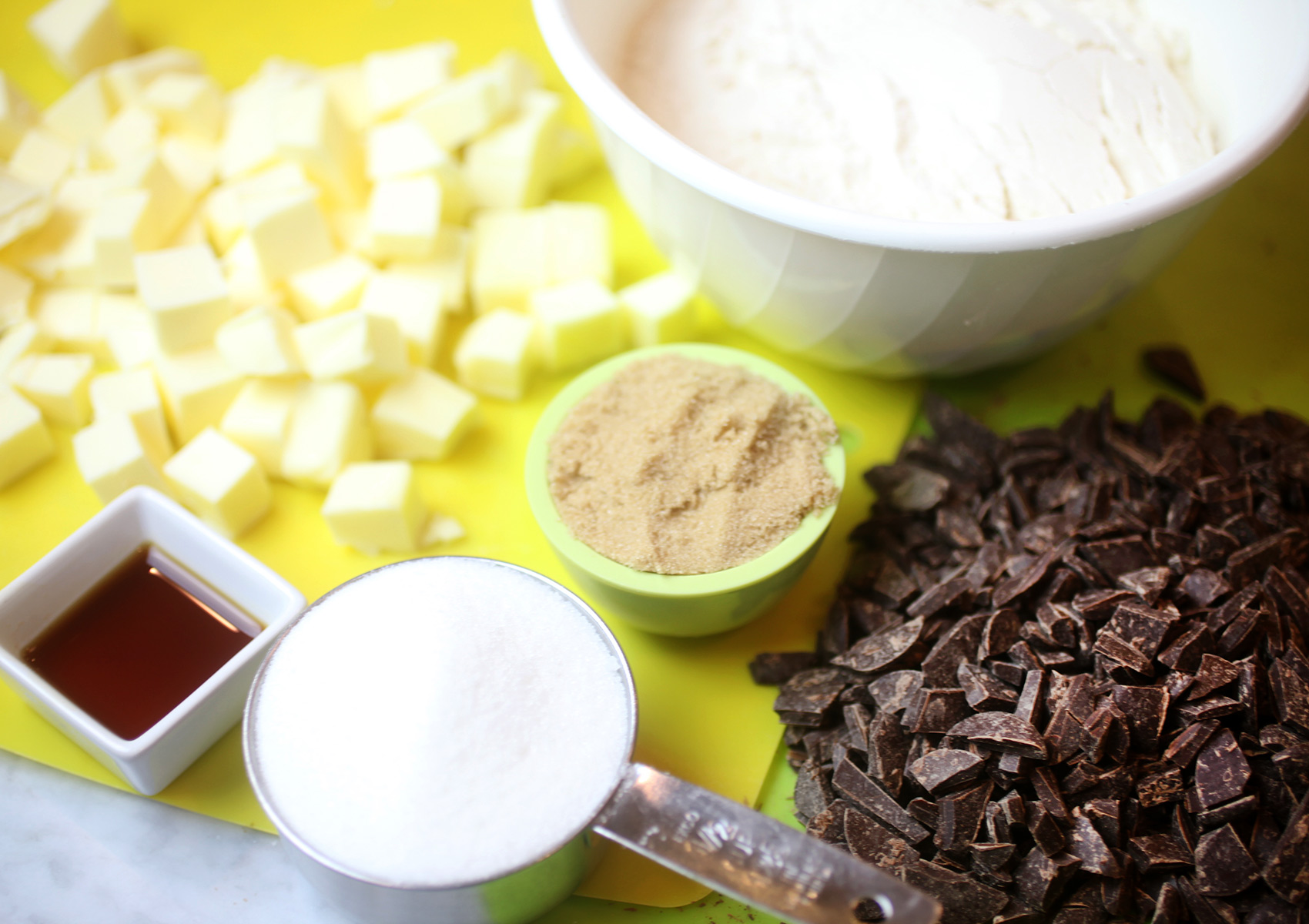
The recipe ingredients are simple. Butter, flour, brown sugar, granulated sugar, vanilla and chunks of chocolate (semisweet or bittersweet). I used semisweet since I had those on hand, but I think I’d love them even more with bittersweet chocolate.
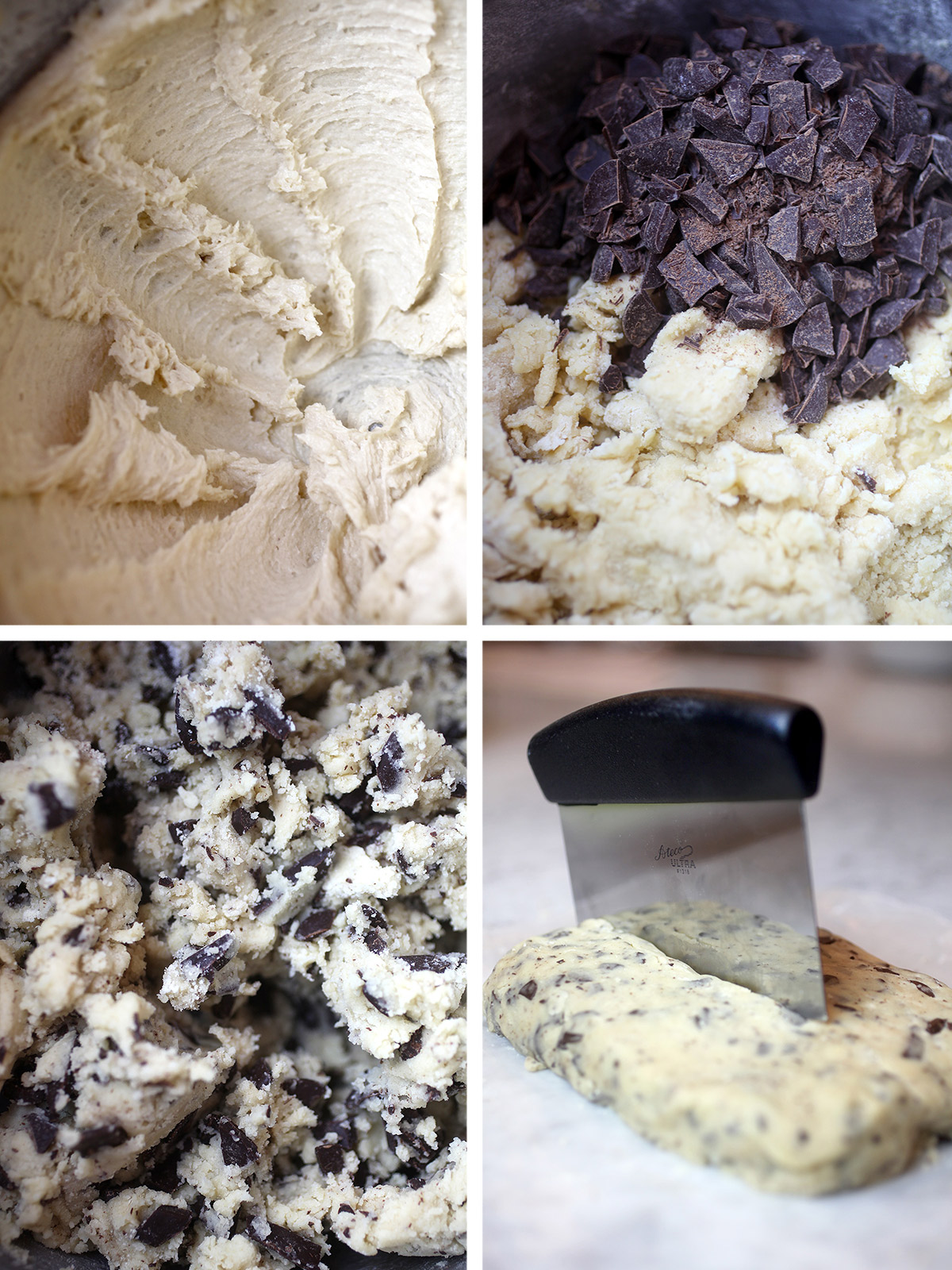
Mix up the cookie dough batter and divide it into two equal parts.

Roll them up into two cylinder shapes and make sure the dough is compact as possible.
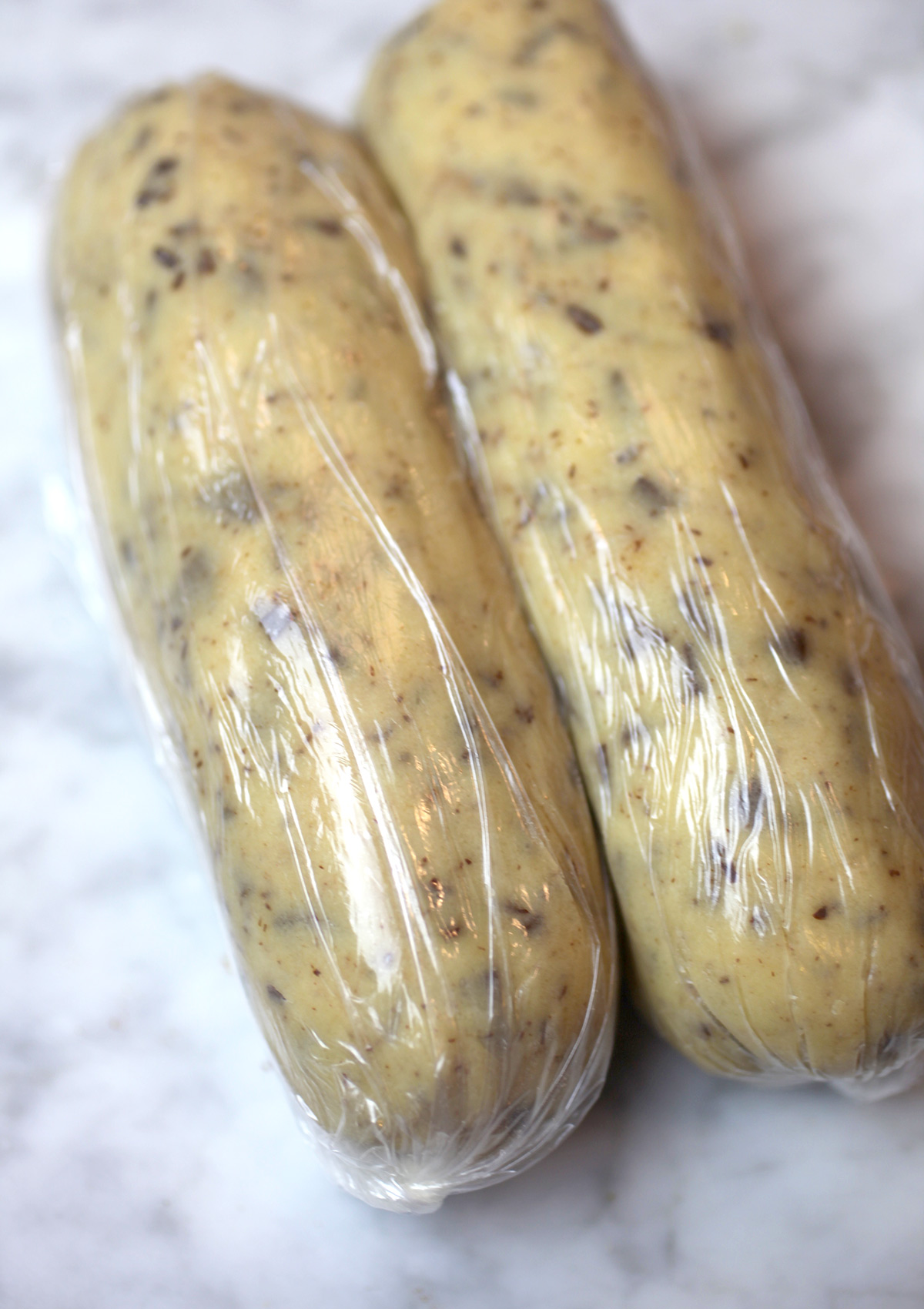
Wrap them in plastic wrap and then chill the dough for at least two hours or until the dough is totally firm. You can also make this dough in advance and chill for several days before baking or freeze it for up to 1 month.

When ready to bake, remove the dough from the fridge and brush with a beaten egg.

Then roll in demerara sugar.
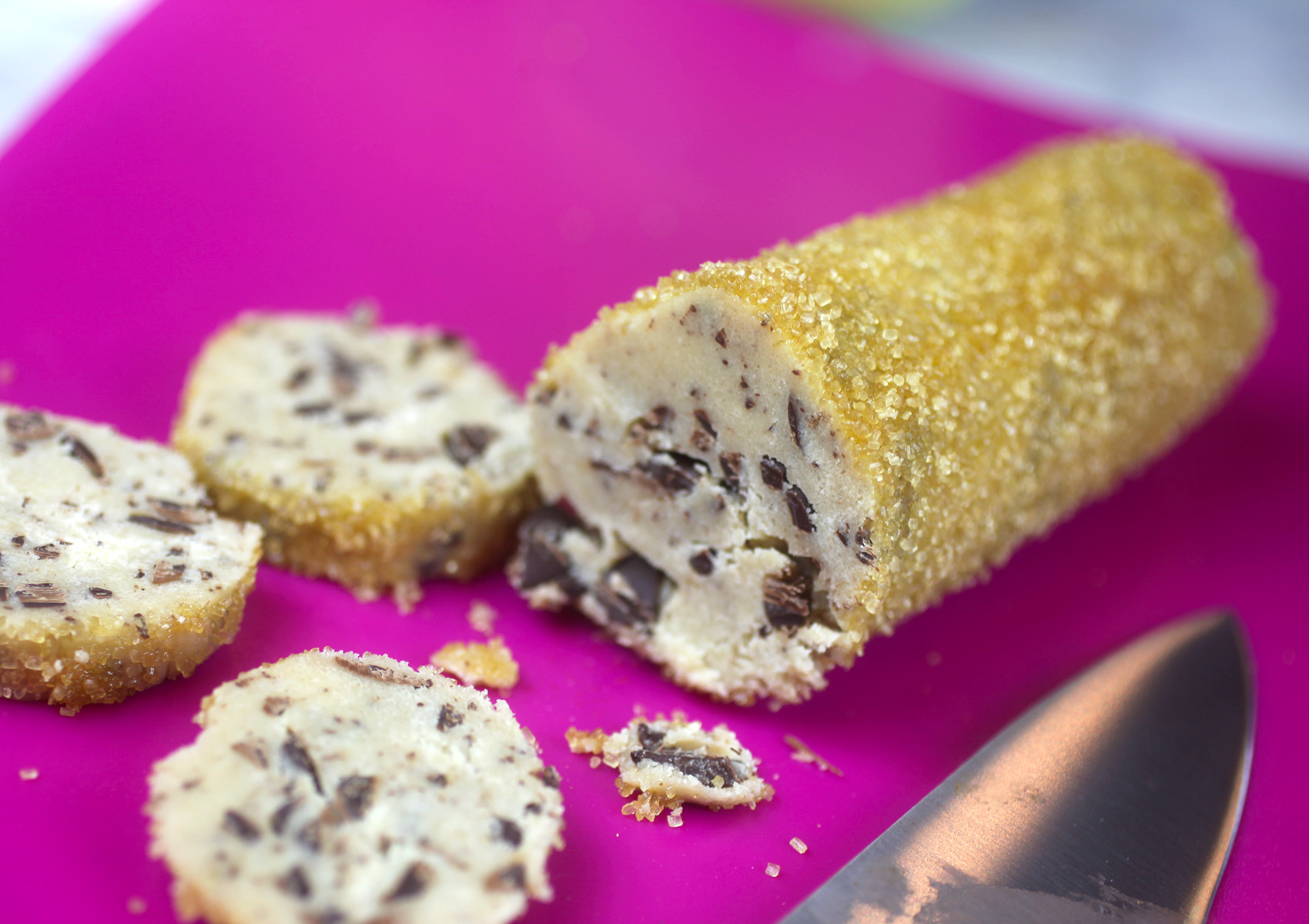
Cut each cylinder shape into 1/2 inch slices. You should end up with 12 slices for each. If the dough separated any, don’t worry. Just press it back together to reshape.
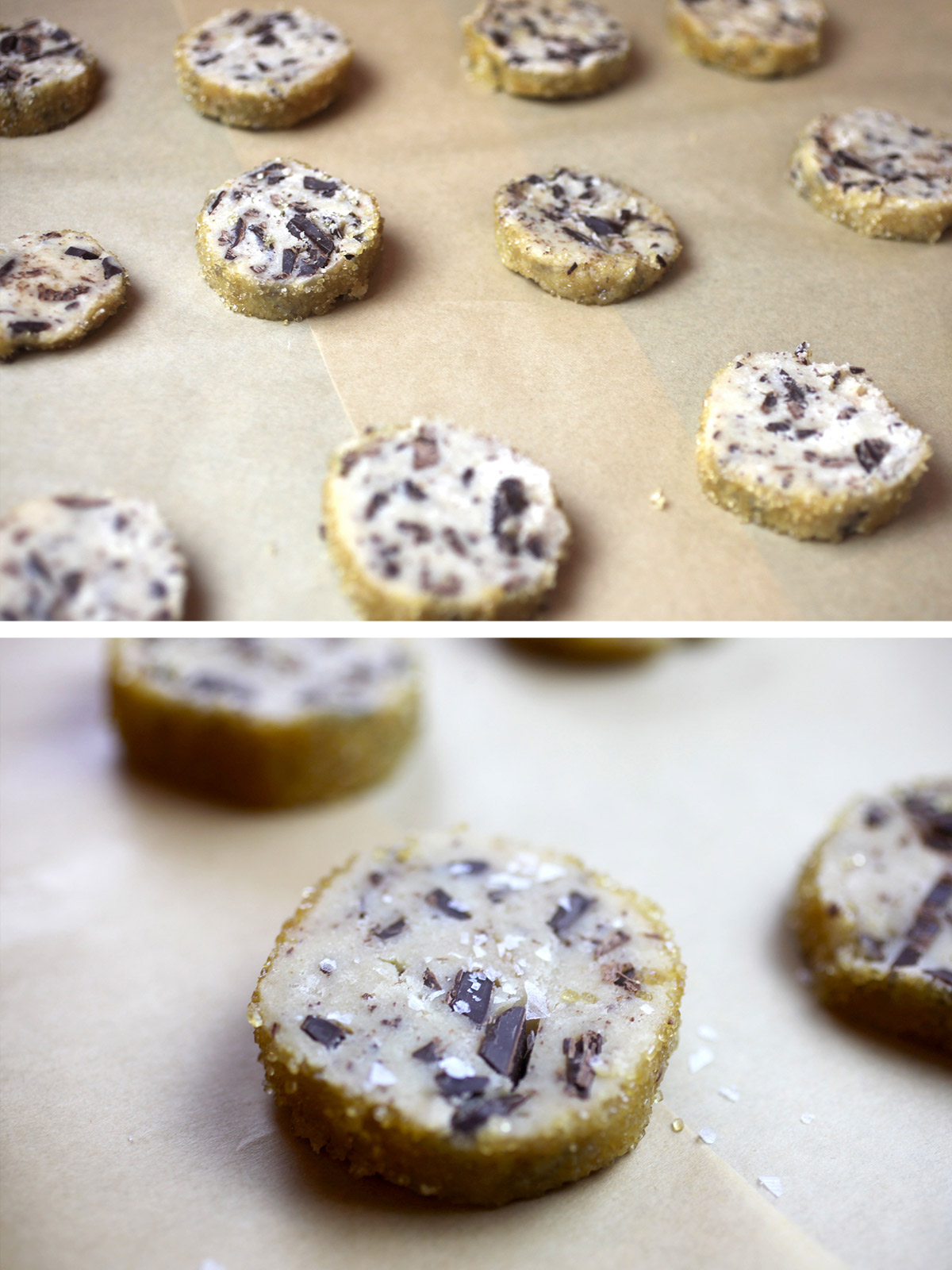
Place on a cookie sheet lined with parchment paper and sprinkle with flaky sea salt. Bake at 350 for 12-15 minutes. Let cool on the cookie sheet after baking and enjoy.
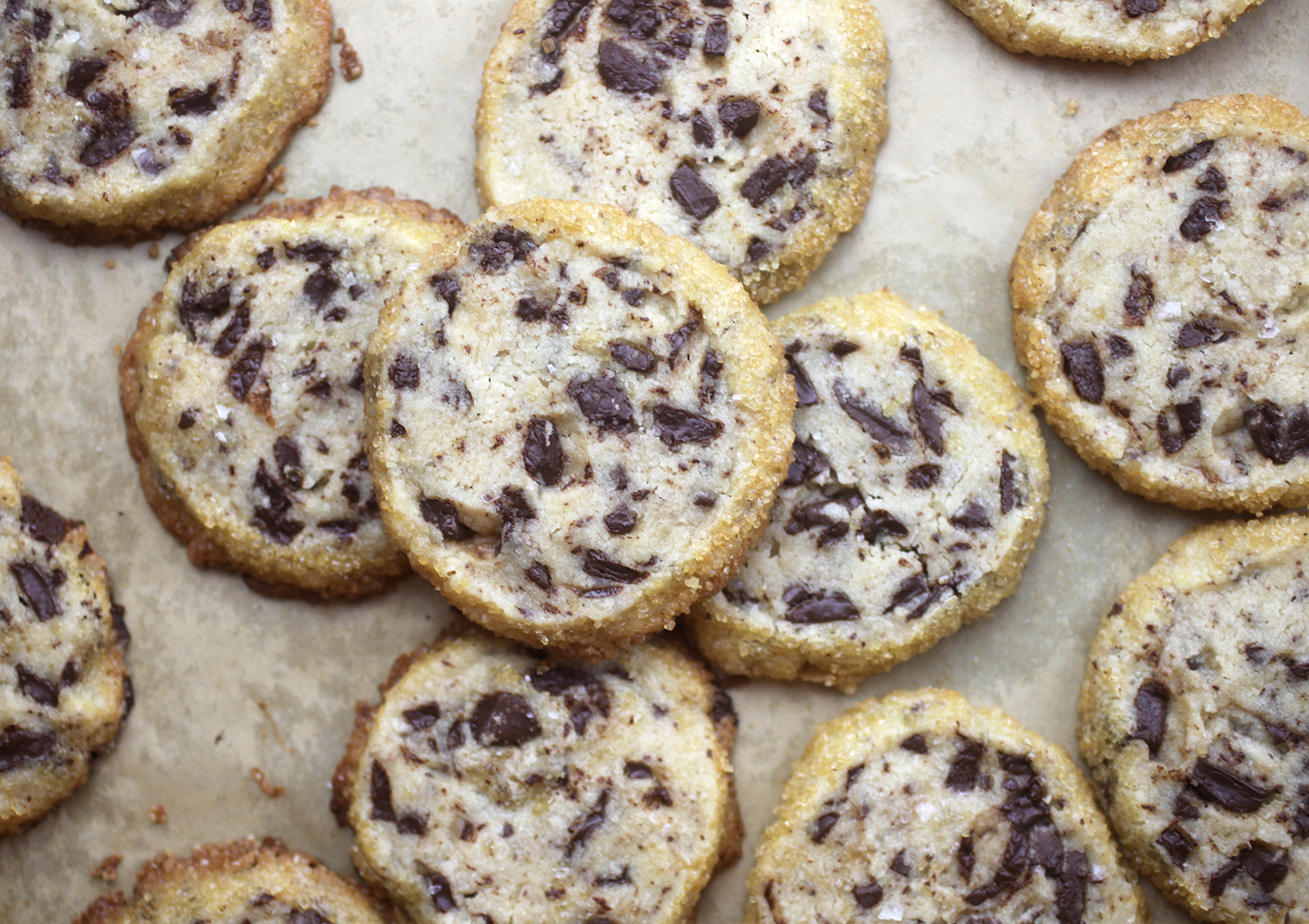
Here’s Alison’s Salted Chocolate Chunk Shortbread Cookie Recipe on the Bon Appetit’s site with full instructions.
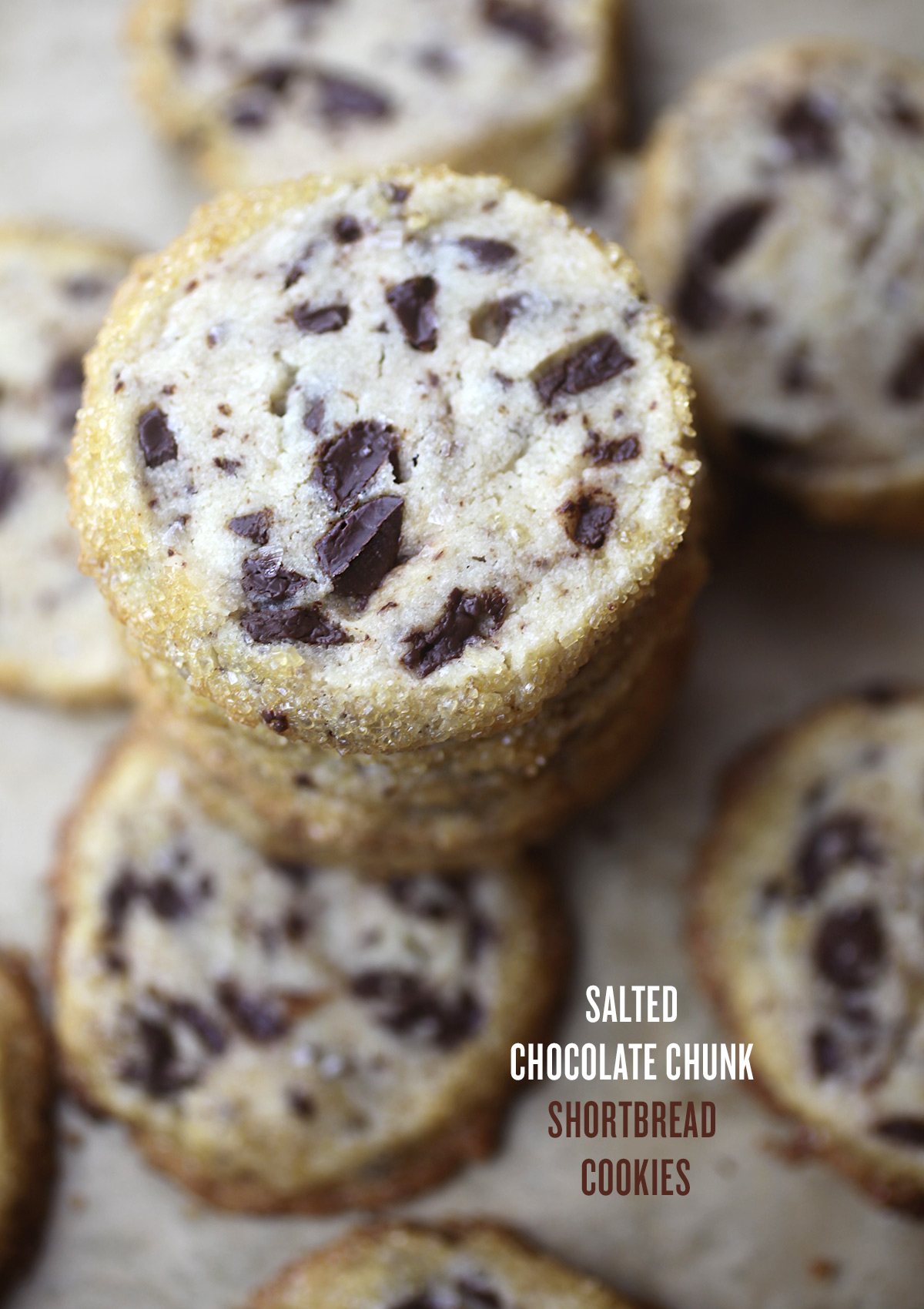
Enjoy!!!
from bakerella.com https://ift.tt/2Ggvosk
What is Marc Pro and How Can It Help to Obtain Your Fitness Goals
from Dai Manuel: Your Lifestyle Mentor https://ift.tt/2Llyo5y